Chinese New Year – Few lines, Short Essay and Full Essay
Essays , Festivals 0
Last Updated on January 25, 2020

Few lines about Chinese New Year
- Chinese new year is also known as Lunar new year
- It is a Chinese festival celebrating the beginning of a new year of the Chinese calendar.
- In mainland china, the day marks the onset of spring and is referred as the Spring Festival.
- In 2020, the Chinese New Year is celebrated on 25th January and it’s a public holiday.
- This Chinese year is called the Year of the Rat.
Brief essay on Chinese New Year
Chinese New Year is a well-known Chinese festival that celebrates the beginning of a new year of the Chinese calendar. It is also known as lunar New Year or the Spring Festival as it marks the onset of spring. The first day of Chinese New Year begins on the new moon day that happens between 21 January and 20 February. In 2020 the Chinese New Year is celebrated on 25th January commencing the Year of the Rat. Chinese New Year is an important holiday in China and the festival is also celebrated worldwide in regions with significant Chinese populations.
Long Essay on Chinese New Year
Chinese New Year marks the beginning of a new year in the Chinese calendar. It is also termed as “Lunar New Year”, “Chinese New Year Festival”, and “Spring Festival”. Generally, the Chinese New Year falls on different dates every year in the Gregorian calendar. It is calculated based on the first new moon day that falls between 21th of January and 20th of February.
Chinese New Year celebrations starting from the New Year eve and ends with the Lantern festival that is held on the 15th day of the year. Chinese New Year is observed as a public holiday in china and in several countries with sizable Chinese and Korean population. It is the longest holidays in china. The holidays mark the end of the winter’s coldest days and people welcome the spring, praying to Gods for the upcoming planting and harvest season.
Different regional customs and traditions accompany the festival. Eating dumplings, Yule Log cake, tang yuan or ‘soup balls’, and red envelopes with ‘lucky’ money are part of customary celebration. According to some Myth, the Chinese New Year festival celebrates the death of a monster called Nian, which was killed by a brave boy with fire crackers on the New Year’s Eve. And that’s why firecrackers is considered the crucial part of the Spring Festival as it is believed to scare off monsters and bad luck.
This year, 2020, Chinese New Year falls on 25th of January is called the year of the Rat.
Related Worksheets and Exercises
- St Patrick’s Day Essay
- Favorite Festival – Diwali
- What is Black Friday? Why we call it Black Friday?
- Rakshabandhan 2017
- Thiruvalluvar Day
- Pongal Festival
- Happy New Year
- Guru Nanak Jayanthi
- Rakshabandhan
Leave a Reply Cancel reply
Your email address will not be published. Required fields are marked *

- Immersion Program
- Learn Chinese Online
- Study Abroad in China
- Custom Travel Programs
- Teach in China
- What is CLI?
- Testimonials
- The CLI Center
- Photo Gallery
A Brief Guide to the Chinese New Year (春节 Chūnjié)
Learn Chinese in China or on Zoom and gain fluency in Chinese!
Join CLI and learn Chinese with your personal team of Mandarin teachers online or in person at the CLI Center in Guilin , China.
Perhaps the most important of all Chinese holidays , the Chinese New Year is celebrated worldwide each January or February in places like Hong Kong, Taiwan, Singapore, Malaysia, Thailand, Cambodia, the Philippines, and Mainland China.
Also called the Spring Festival (春节 Chūnjié), the Chinese New Year celebrates the beginning of the Chinese year based on the traditional Chinese lunisolar calendar and officially ends 14 days later with the Lantern Festival .
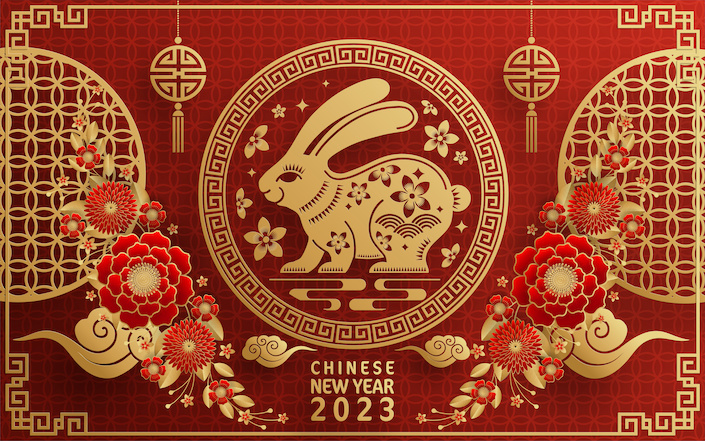
Table of Contents
Learn Chinese with CLI
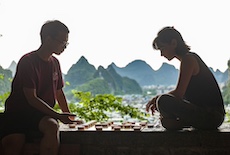
How is Chinese New Year celebrated?
Spring Festival is a time for families to come together, exchange money-filled red envelopes (红包, hóngbāo) , and enjoy delicious Chinese food.
The Chinese New Year is a 15-day holiday and includes a variety of festivities depending on the region and its local traditions and customs. However, certain common customs are shared regardless of region.
For example, it is common practice to decorate one’s home with Chinese lanterns . In many homes, you will find auspicious Chinese characters and couplets on red paper stuck on doors. Red is an auspicious color as it scares away the Nian monster . Wearing new clothes is also a common tradition to ward off bad luck—a new year is a time for newness after all!
View this post on Instagram A post shared by Chinese Language Institute (@studycli)
The Chinese New Year is an important time to 拜年 (bàinián, to pay a new year call), so it is common practice to visit relatives and exchange auspicious greetings and Chinese gifts , including the ever-popular lucky red envelopes filled with Chinese currency . Devoted Buddhist and Daoist practitioners also often visit local temples to welcome the new year.
The holiday has even had an influence on the traditional festivals of other cultures with whom the Chinese have historically interacted, including the Koreans, Vietnamese, Mongolians, and Japanese.
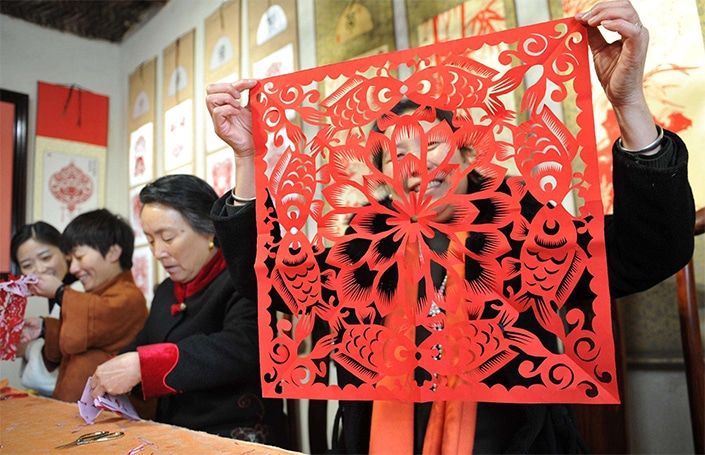
What foods are eaten during Chinese New Year?
Family is of central importance in traditional Chinese culture, and Spring Festival is generally a very family-oriented holiday.
The New Year’s Eve dinner (年夜饭 niányèfàn) kick starts the tradition of family reunions. In fact, the Chinese Spring Festival also marks the world’s largest human migration, as overseas Chinese and Chinese migrant laborers return home to celebrate the advent of the new year alongside their families.
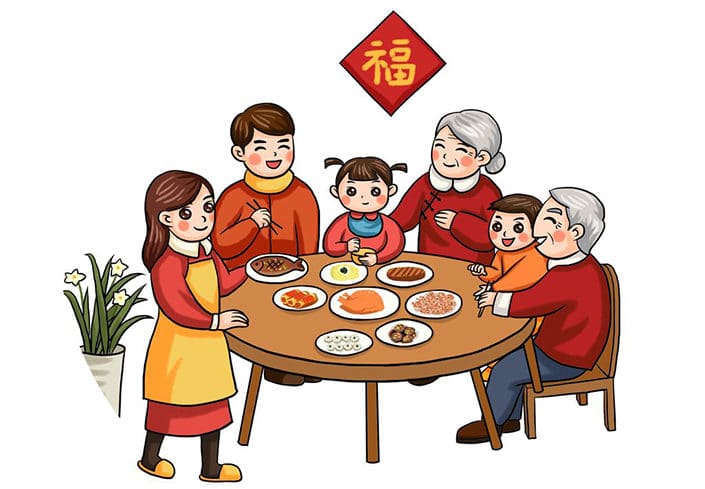
Though traditions can vary between northern and southern China, here are a few examples of common “auspicious foods” presented at reunion dinners:
1. Steamed Fish | 蒸鱼 | zhēng yú
As you may already know, the Chinese language includes many homophones (同音词 tóngyīncí), which results in many characters and words having the same pronunciation as one another.
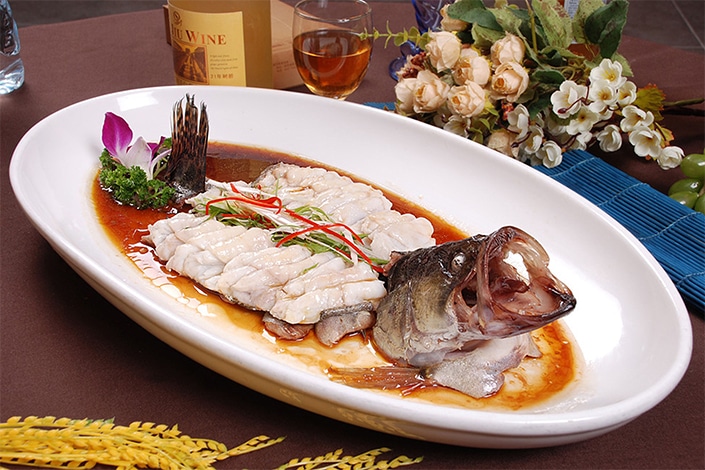
In this instance, “fish” (鱼 yú) has the same pronunciation as “surplus” (余 yú). There is also a typical New Year greeting, 年年有余 (niánnián yǒuyú), which translates to “may you have a surplus (of blessings) every year”. Therefore, eating fish symbolizes an increase in prosperity.
2. New Year Cake | 年糕 | niángāo
Sticky rice cakes symbolize a prosperous year to come, as “cake” (糕 gāo) has the same pronunciation as “high/lofty” (高 gāo). This coincides with the greeting 年年高升 (niánniángāoshēng; “advance year after year”). Rice cakes are a must during Chinese New Year festivities!
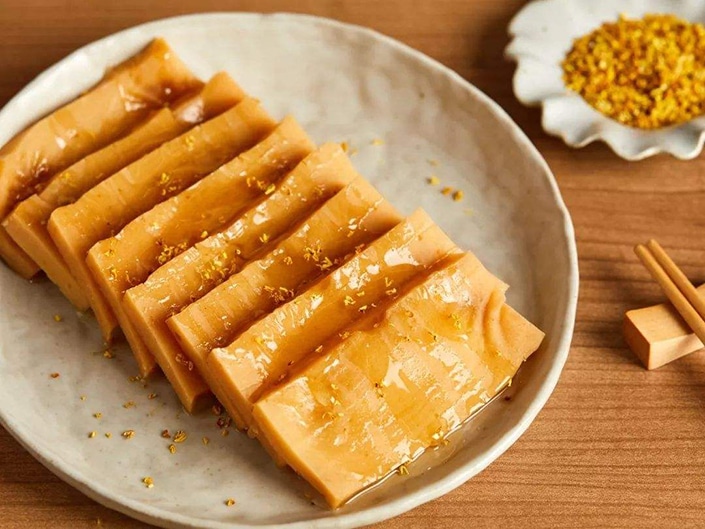
3. Spring Rolls | 春卷 | chūnjuǎn
How can you start spring without spring rolls? This delicacy was originally a seasonal food that was consumed only during the spring. Eating spring rolls is a way to welcome the arrival of spring, and their golden color also symbolizes wealth and prosperity.
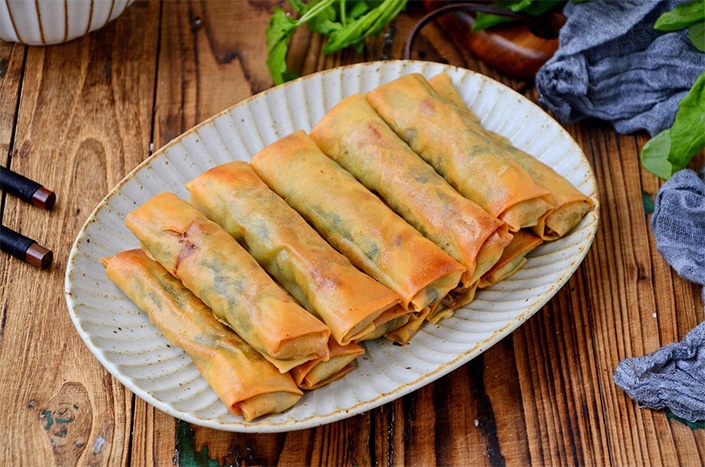
4. Fruits | 水果 | shuǐguǒ
Fruits are commonly enjoyed as desserts and snacks during Spring Festival celebrations. They symbolize life and new beginnings and are also a common new year gift.
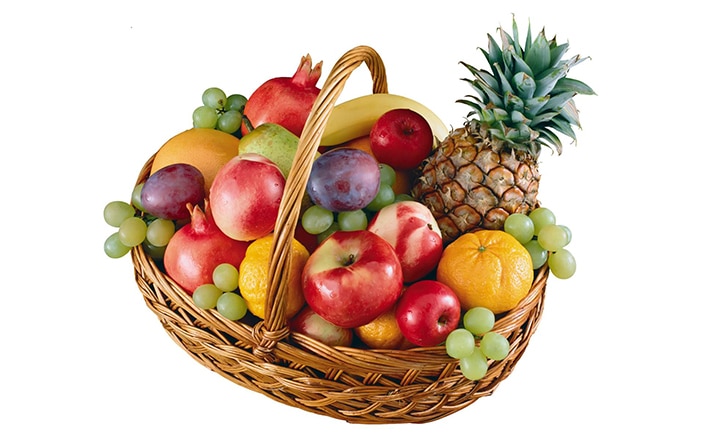
5. Dumplings | 饺子 | jiǎozi
Due to their resemblance to imperial coins (元宝 yuánbǎo), dumplings are representative of wealth and fortune.
6. “Longevity Noodles” | 长寿面 | chángshòumiàn
“Longevity noodles” are a kind of flat Cantonese egg noodles which are usually consumed during special occasions (such as the Chinese New Year and birthdays).
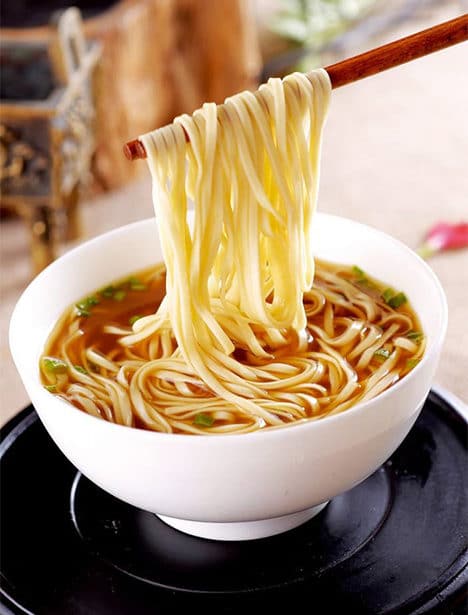
As their name indicates, their long strings represent longevity and living to a ripe old age. The trick is to eat them in a single mouthful and not cut the noodles short!
7. Tangyuan | 汤圆 | tāngyuán
The fifteenth and final day of the new year holiday is celebrated by the Lantern Festival (元宵节 Yuánxiāojié). During this time, it is common to eat a Chinese dessert called tāngyuán (汤圆), which consists of sweet glutinous rice balls filled with a variety of fillings such as sesame, peanut, and red bean paste. Their round shapes represent togetherness and reunion.
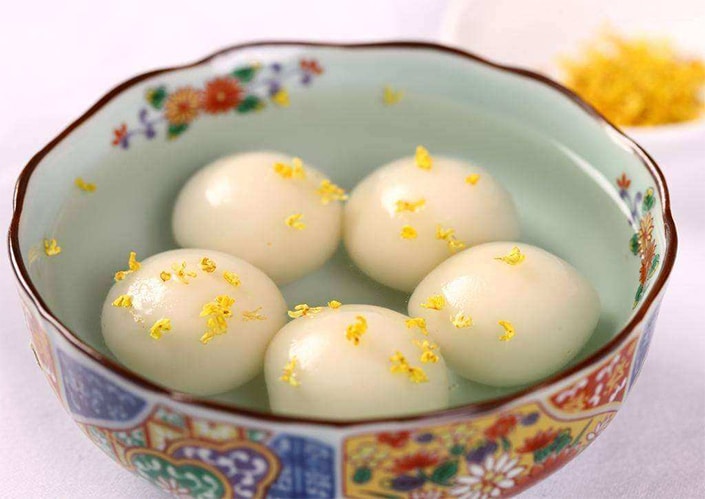
How to Say Happy New Year in Chinese
Would you like to wish a friend, colleague, or loved one Happy New Year in Chinese? Read on to learn this festive phrase and more!
Cultural note: In China, people often hold a fist salute or 抱拳礼 (bàoquánlǐ) when saying the below greetings. Remember that this method of greeting is mainly used during formal occasions, so we suggest to avoid using it during informal encounters!
1. 新年快乐 (Xīnnián Kuàilè) - Happy New Year!
Saying “Xīnnián Kuàilè” is the simplest and most straightforward way to wish your Chinese friends, family and colleagues a happy new year. Want to know how to pronounce it? Just watch the following video and repeat!
2. 恭喜发财 (gōngxǐfācái) - May you have a prosperous year!
In addition to 新年快乐 (Xīnnián Kuàilè), this is probably the most popular saying you'll hear around the Chinese New Year. It has been the center of many 贺年歌曲 (hènián gēqǔ, Chinese New Year songs) and literally means “congratulations, make a fortune!”
Learn to sing along to the famous Chinese New Year song “恭喜” (gōngxǐ) in the following video.
兔年大吉 (tùnián dàjí) - Happy Year of the Rabbit (2023)
大吉 (dàjí) is a noun meaning very auspicious or lucky. You can put any given year's zodiac animal year before 大吉 and use it as a general new year greeting. You can also simply say 大吉大利 (dàjídàlì), which means “good luck and great prosperity.”
To learn how to say other year-specific Spring Festival greetings, see the Spring Festival Chinese Vocabulary List toward the bottom of this article.
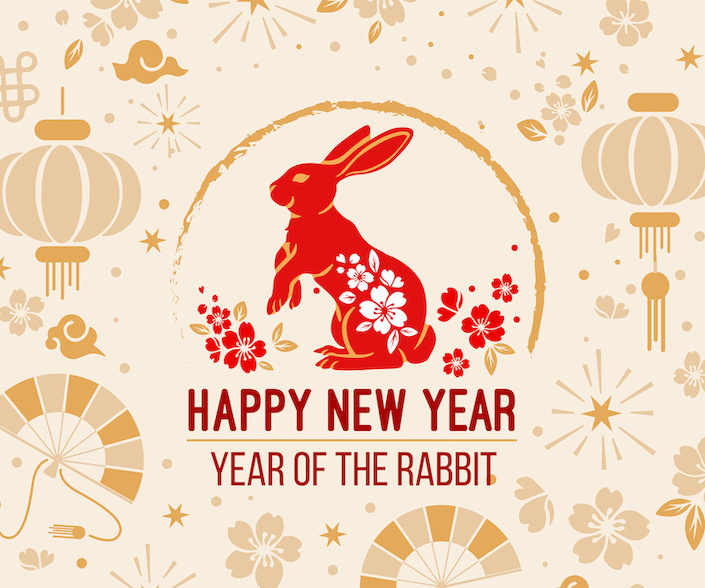
4. 岁岁平安 (suìsuì píng'ān) - May you have peace year after year
A fun things aspect of Chinese is wordplay based on 同音词 (tóngyīncí, homophones). A great example of this is 岁岁平安. Breaking things during the Chinese new year is a taboo in China as it is believed to bring bad luck resulting in money loss and a family split in the future.
If something does break, you can say “碎碎平安” (suìsuìpíngān) which sounds exactly the same as “岁岁平安” (suìsuìpíngān) . “碎” means to break, whereas “岁” means age or year and is the character used in 岁岁平安. This is a very clever way to negate all that bad luck!
5. 万事如意 (wànshìrúyì) - May all your hopes be fulfilled
万 literally means “ten thousand” or “a great number.” When you say 万事如意 to your Chinese friends, you are literally wishing that all matters (万事, ten thousand matters/affairs) be according to his/her wishes (如意)。
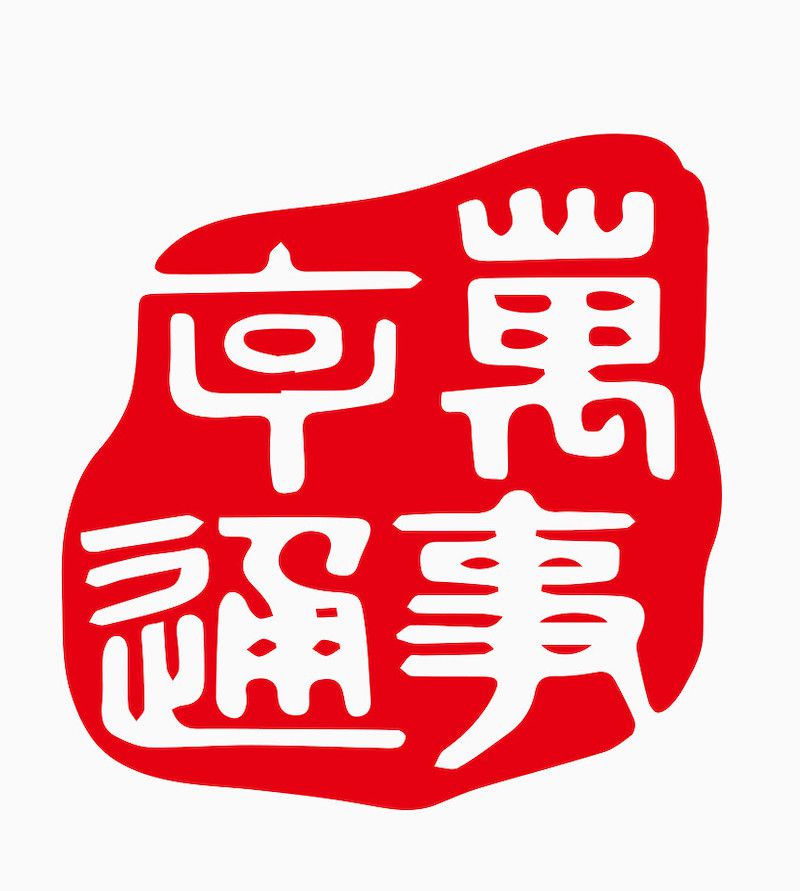
What are some taboos during Spring Festival?
All auspicious things aside, there are certain taboos that must be avoided during Chinese New Year:
1. No cleaning!
Any type of “spring cleaning” must take place before the new year and never during the actual holiday. This allows the cleaned space to be filled with the new blessings and fortunes of the new year. Cleaning during the holiday consequently means that you are getting rid of these new fortunes!
2. No wearing black or white!
In Chinese color symbolism, black signifies evil and white is the color of death and used for funerals. Instead, auspicious colors such as red and gold are often worn during the new year.
3. No cutting hair!
发 fā (hair) is also the character and sound for 发财 fā cái (to get rich), so cutting hair signifies a loss of fortune.
4. No breaking things!
碎 suì means to break, whereas 岁 suì means age or year. If something does break, you can say “碎碎平安” (suì suì píng ān) which sounds exactly the same as “岁岁平安” (“may you have peace year after year”).
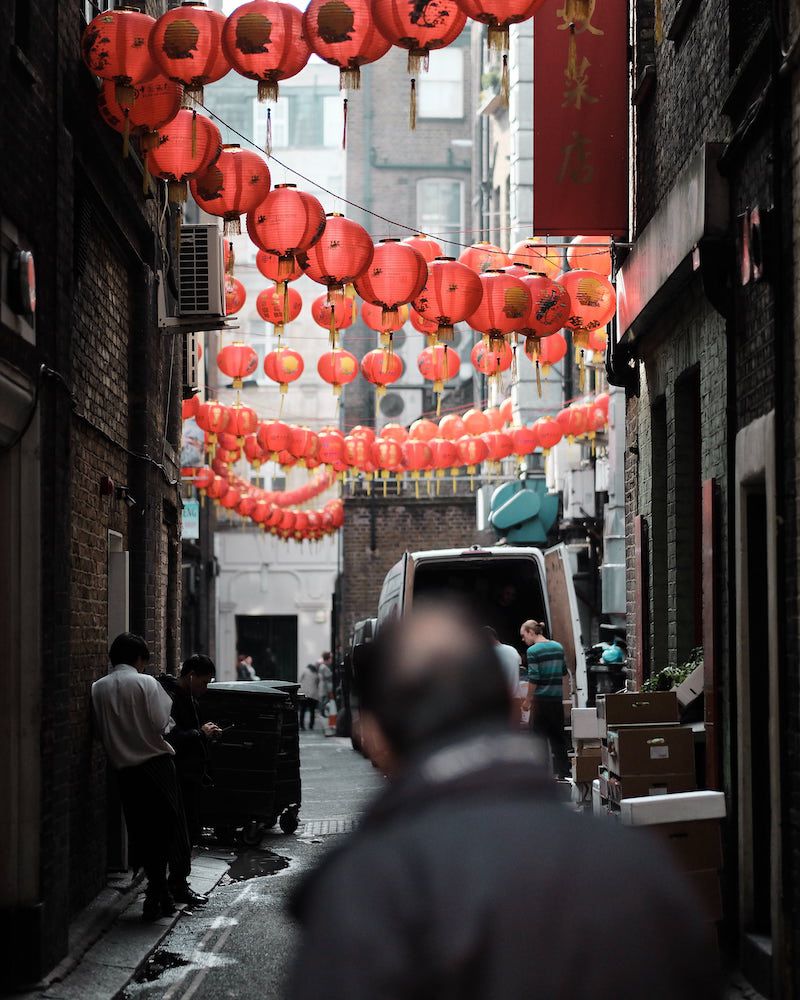
Why is it called the “Lunar” New Year?
The term “lunar” is an English adaptation, mainly because the holiday starts with the new moon, ends with the full moon 14 days later, and is thus based on the Chinese lunisolar calendar . The name of the holiday in Chinese, 春节 Chūnjié, literally translates to “Spring Festival”.

Chinese Zodiac Animal Signs
The Chinese New Year is also a time when the annual zodiac sign changes, meaning that each year is assigned to a specific zodiac animal. Zodiac signs play an integral role in Chinese culture. It is said that your luck regarding financial situations, health and relationships for each year can be calculated based on your zodiac sign.
To ask your Chinese friends and colleagues what their zodiac animal is, just say "你属什么? (nǐ shǔ shénme?)". 属 shǔ can mean “to belong to” or “to be born in the year of". In China, it is common to be asked how old you are or what your 生肖 (shēngxiào, Chinese zodiac sign) is.
In response, you can say: 我属 (wǒ shǔ) + insert animal. For example: “我属牛” (Wǒ shǔ niú, I was born in the Year of the Ox ). Consult CLI's article on the 12 Chinese Zodiac Animals for an in-depth look at this cultural phenomena and to find out what your own zodiac sign is!
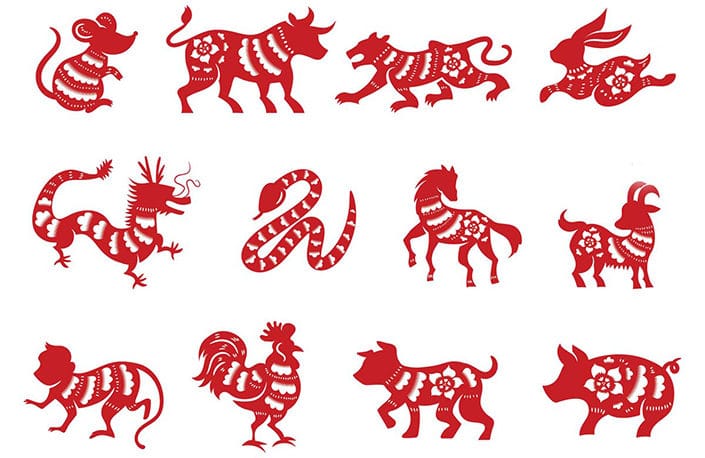
The Chinese New Year Through a Local's Eyes
In our Spring Festival video, we invite you to peer into the life of a Guilin resident who walked the same arduous path traveled by so many in China from poverty to prosperity. Join Dayong, a CLI team member since 2009, as he converses with Uncle Ye (叶叔叔, Yè Shūshu) about how his quality of life has changed for the better over the decades.
While watching the video, follow along in this downloadable Chinese-English transcript for the Chinese characters, Chinese pinyin , and English translation.
Chinese Vocabulary for the Spring Festival
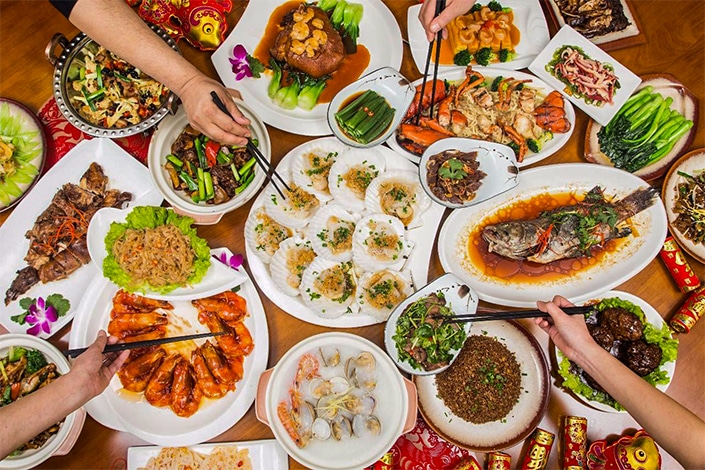
Join a Spring Festival Celebration and Practice Your Chinese
We hope this article helped you learn more about the Chinese New Year! It is truly a fun and festive holiday that is celebrated all across the world. Spring Festival is a time for family reunions, showing appreciation for one’s friends, and delicious feasts.
If you are in China during Spring Festival, we hope you'll get to experience this important holiday for yourself by participating in some Chinese New Year activities with friends or colleagues. Keep in mind that many people will be traveling back and forth during this period as part of the famous Spring Festival travel rush (春运 chūnyùn). If you do plan to go anywhere during this period, especially by train , make sure to buy your tickets far in advance.
If you aren't in China, we encourage you to seek out your local Chinese community, attend holiday events, and even volunteer to help prepare for the Chinese New Year festivities. This is a great way to learn more about Chinese culture and to immerse yourself in the Chinese language .
And now that you know some Chinese New Year greetings, it is time to put them to use! On behalf of the CLI team, we wish you a wonderful Chinese New Year and welcome you to learn Chinese in China . 祝大新年快乐,身体健康,万事如意 !

Free 30-minute Trial Lesson
Continue exploring.
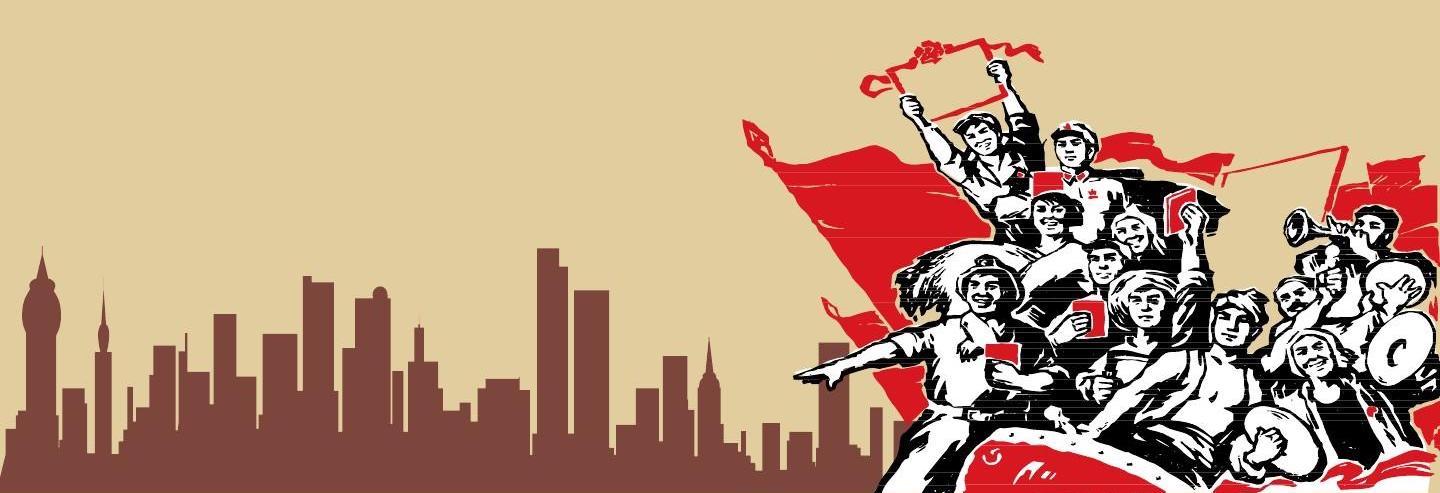
- Chinese Holidays
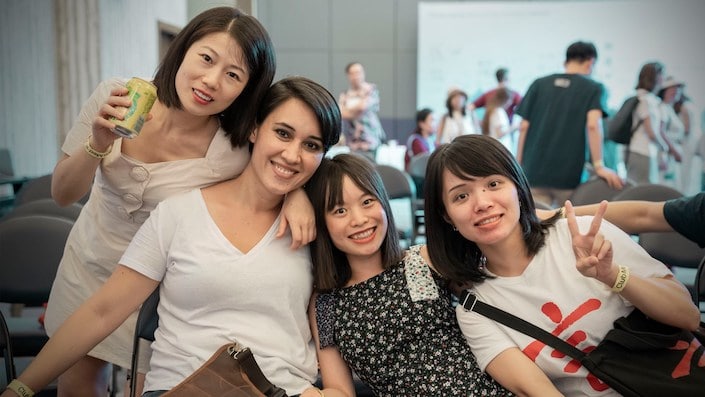
Copyright 2024 | Terms & Conditions | FAQ | Learn Chinese in China
- HISTORY & CULTURE
Why Lunar New Year prompts the world’s largest annual migration
Observed by billions of people, the festival also known as Chinese New Year or Spring Festival is marked by themes of reunion and hope.

Celebrated around the world, it usually prompts the planet’s largest annual migration of people. And though it is known to some in the West as Chinese New Year , it isn’t just celebrated in China. Lunar New Year falls this year on February 10, 2024, kicking off the Year of the Dragon. It is traditionally a time for family reunions, plenty of food, and some very loud celebrations.
What is the Lunar New Year?
Modern China actually uses a Gregorian calendar like most of the rest of the world. Its holidays, however, are governed by its traditional lunisolar calendar , which may have been in use from as early as the 21st century B.C. When the newly founded Republic of China officially adopted the Gregorian calendar in 1912, its leaders rebranded the observation of the Lunar New Year as Spring Festival, as it is known in China today.
( Learn why some people celebrate Christmas in January. )
As its name suggests, the date of the lunar new year depends on the phase of the moon and varies from year to year. Each year in the lunar calendar is named one of the 12 animals in the Chinese zodiac , which are derived from ancient Chinese folklore. Repeating in a rotating basis, these animals are the rat, ox, tiger, rabbit, dragon, snake, horse, goat, monkey, rooster, dog, and pig.

Today, Spring Festival is celebrated in China and Hong Kong; Lunar New Year is also celebrated in South Korea, Tibet, Vietnam, Singapore, Indonesia, Malaysia, and places with large Chinese populations. Though the festival varies by country, it is dominated by themes of reunion and hope.
How Lunar New Year is celebrated
For Chinese people, Spring Festival lasts for 40 days and has multiple sub-festivals and rituals. The New Year itself is a seven-day-long state holiday, and on the eve of the new year, Chinese families traditionally celebrate with a massive reunion dinner. Considered the year’s most important meal, it is traditionally held in the house of the most senior family member.
( Learn about Lunar New Year with your kids. )
The holiday may be getting more modern, but millennia-old traditions are still held dear in China and other countries. In China, people customarily light firecrackers, which are thought to chase away the fearful monster Nian. (However, the tradition has been on the decline in recent years due to air pollution restrictions that have hit the fireworks industry hard.) The color red is used in clothing and decorations to ensure prosperity, and people exchange hongbao , red envelopes filled with lucky cash.
Meanwhile in Korea, people make rice cake soup and honor their ancestors during Seollal . And during Tet, the Vietnamese Lunar New Year, flowers play an important role in the celebrations.

Lunar New Year has even spawned its own form of travel: During chunyun , or spring migration, hundreds of million people travel to their hometowns in China for family reunions and New Year’s celebrations. In past years, billions of travelers have taken to the road during the 40-day period. Known as the world’s largest human migration, chunyun regularly clogs already busy roads, trains and airports—proof of the holiday’s enduring significance for those who associate it with luck and love.
This story was originally published on January 2, 2020. It has been updated.
FREE BONUS ISSUE
Related topics.
- HUMAN MIGRATION
- IMPERIAL CHINA
You May Also Like

This ancient festival is a celebration of springtime—and a brand new year

How the nation chooses its best and brightest Christmas trees

Why Swedish children celebrate Easter by dressing up as witches

Meet 5 of history's most elite fighting forces

These two ancient empires shaped Passover
- History & Culture
- Photography
- Environment
- Paid Content
History & Culture
- Mind, Body, Wonder
- Terms of Use
- Privacy Policy
- Your US State Privacy Rights
- Children's Online Privacy Policy
- Interest-Based Ads
- About Nielsen Measurement
- Do Not Sell or Share My Personal Information
- Nat Geo Home
- Attend a Live Event
- Book a Trip
- Inspire Your Kids
- Shop Nat Geo
- Visit the D.C. Museum
- Learn About Our Impact
- Support Our Mission
- Advertise With Us
- Customer Service
- Renew Subscription
- Manage Your Subscription
- Work at Nat Geo
- Sign Up for Our Newsletters
- Contribute to Protect the Planet
Copyright © 1996-2015 National Geographic Society Copyright © 2015-2024 National Geographic Partners, LLC. All rights reserved
- History Classics
- Your Profile
- Find History on Facebook (Opens in a new window)
- Find History on Twitter (Opens in a new window)
- Find History on YouTube (Opens in a new window)
- Find History on Instagram (Opens in a new window)
- Find History on TikTok (Opens in a new window)
- This Day In History
- History Podcasts
- History Vault
Lunar New Year 2024
By: History.com Editors
Updated: February 9, 2024 | Original: February 4, 2010

Lunar New Year is one of the most important celebrations of the year among East and Southeast Asian cultures, including Chinese, Vietnamese and Korean communities, among others. The New Year celebration is celebrated for multiple days—not just one day as in the Gregorian calendar’s New Year.
This Lunar New Year, which begins on February 10, is the Year of the Dragon.
China’s Lunar New Year is known as the Spring Festival or Chūnjié in Mandarin, while Koreans call it Seollal and Vietnamese refer to it as Tết .
Tied to the lunar calendar, the holiday began as a time for feasting and to honor household and heavenly deities, as well as ancestors. The New Year typically begins with the first new moon that occurs between the end of January and spans the first 15 days of the first month of the lunar calendar—until the full moon arrives.
Zodiac Animals
Each year in the Lunar calendar is represented by one of 12 zodiac animals included in the cycle of 12 stations or “signs” along the apparent path of the sun through the cosmos.
The 12 zodiac animals are the rat, ox, tiger, rabbit, dragon, snake, horse, sheep, monkey, rooster, dog and pig. In addition to the animals, five elements of earth, water, fire, wood and metal are also mapped onto the traditional lunar calendar. Each year is associated with an animal that corresponds to an element.
The year 2024 is slated to be the year of the dragon—an auspicious symbol of power, wisdom and good fortune. The year of the dragon last came up in 2012.
Lunar New Year Foods and Traditions
Each culture celebrates the Lunar New Year differently with various foods and traditions that symbolize prosperity, abundance and togetherness. In preparation for the Lunar New Year, houses are thoroughly cleaned to rid them of inauspicious spirits, which might have collected during the old year. Cleaning is also meant to open space for good will and good luck.
Some households hold rituals to offer food and paper icons to ancestors. Others post red paper and banners inscribed with calligraphy messages of good health and fortune in front of, and inside, homes. Elders give out envelopes containing money to children. Foods made from glutinous rice are commonly eaten, as these foods represent togetherness. Other foods symbolize prosperity, abundance and good luck.
Chinese New Year is thought to date back to the Shang Dynasty in the 14th century B.C. Under Emperor Wu of Han (140–87 B.C.), the tradition of carrying out rituals on the first day of the Chinese calendar year began.
“This holiday has ancient roots in China as an agricultural society. It was the occasion to celebrate the harvest and worship the gods and ask for good harvests in times to come," explains Yong Chen, a scholar in Asian American Studies.
During the Cultural Revolution in 1967, official Chinese New Year celebrations were banned in China. But Chinese leaders became more willing to accept the tradition. In 1996, China instituted a weeklong vacation during the holiday—now officially called Spring Festival—giving people the opportunity to travel home and to celebrate the new year.
Did you know? San Francisco, California, claims its Chinese New Year parade is the biggest celebration of its kind outside of Asia. The city has hosted a Chinese New Year celebration since the Gold Rush era of the 1860s, a period of large-scale Chinese immigration to the region.
Today, the holiday prompts major travel as hundreds of millions hit the roads or take public transportation to return home to be with family.
Among Chinese cultures, fish is typically included as a last course of a New Year’s Eve meal for good luck. In the Chinese language, the pronunciation of “fish” is the same as that for the word “surplus” or “abundance.” Chinese New Year’s meals also feature foods like glutinous rice ball soup, moon-shaped rice cakes (New Year’s cake) and dumplings ( Jiǎozi in Mandarin). Sometimes, a clean coin is tucked inside a dumpling for good luck.
The holiday concludes with the Lantern Festival, which is celebrated on the last day of New Year's festivities. Parades, dances, games and fireworks mark the finale of the holiday.
In Vietnamese celebrations of the holiday, homes are decorated with kumquat trees and flowers such as peach blossoms, chrysanthemums, orchids and red gladiolas. As in China, travel is heavy during the holiday as family members gather to mark the new year.
Families feast on five-fruit platters to honor their ancestors. Tết celebrations can also include bánh chưng , a rice cake made with mung beans, pork, and other ingredients wrapped in bamboo leaves. Snacks called mứt tết are commonly offered to guests. These sweet bites are made from dried fruits or roasted seeds mixed with sugar.
In Korea, official Lunar New Year celebrations were halted from 1910-1945. This was when the Empire of Japan annexed Korea and ruled it as a colony until the end of World War II . Celebrations of Seollal were officially revived in 1989, although many families had already begun observing the lunar holiday. North Korea began celebrating the Lunar New Year according to the lunar calendar in 2003. Before then, New Year's was officially only observed on January 1. North Koreans are also encouraged to visit statues of founder Kim Il Sung, and his son Kim Jong Il, during the holidays and provide an offering of flowers.
Among both North and South Koreans, sliced rice cake soup ( tteokguk ) is prepared to mark the Lunar New Year holiday. The clear broth and white rice cakes of tteokguk are believed to symbolize starting the year with a clean mind and body. Rather than giving money in red envelopes, as in China and Vietnam, elders give New Year's money in white and patterned envelopes.
Traditionally, families gather from all over Korea at the house of their oldest male relative to pay their respects to both ancestors and elders. Travel is less common in North Korea and families tend to mark the holiday at home.
Lunar New Year Greetings
Cultures celebrating Lunar New Year have different ways of greeting each other during the holiday. In Mandarin, a common way to wish family and close friends a happy New Year is “ Xīnnián hǎo ,” meaning “New Year Goodness” or “Good New Year.” Another greeting is “ Xīnnián kuàilè, ” meaning "Happy New Year."
Traditional greetings during Tết in Vietnam are “Chúc Mừng Năm Mới” (Happy New Year) and “Cung Chúc Tân Xuân” (gracious wishes of the new spring). For Seollal, South Koreans commonly say "Saehae bok mani badeuseyo” (May you receive lots of luck in the new year), while North Koreans say "Saehaereul chuckhahabnida” (Congratulations on the new year).
— huiying b. chan , Research and Policy Analyst on the Education Justice Research and Organizing Collaborative team at the New York University Metro Center, edited this report.
"Lunar New Year origins, customs explained," by Laura Rico, University of California, Irvine , February 19, 2015.
"Everything you need to know about Vietnamese Tết," Vietnam Insider , December 3, 2020.
"Seollal, Korean Lunar New Year," by Brendan Pickering, Asia Society .
"The Origin of Chinese New Year," by Haiwang Yuan, Western Kentucky University TopSCHOLAR , February 1, 2016.
"The Lunar New Year: Rituals and Legends," Asia for Educators .

Sign up for Inside History
Get HISTORY’s most fascinating stories delivered to your inbox three times a week.
By submitting your information, you agree to receive emails from HISTORY and A+E Networks. You can opt out at any time. You must be 16 years or older and a resident of the United States.
More details : Privacy Notice | Terms of Use | Contact Us
The Origin and History of Chinese New Year: When Start and Why
Chinese New Year, also known as the Lunar New Year or the Spring Festival, is the most important among the traditional Chinese festivals. The origin of the Chinese New Year Festival can be traced back to about 3,500 years ago . Chinese New Year has evolved over a long period of time and its customs have undergone a long development process.
A Legend of the Origin of Chinese New Year
Like all traditional festivals in China, Chinese New Year is steeped with stories and myths. One of the most popular is about the mythical beast Nian (/nyen/), who ate livestock, crops, and even people on the eve of a new year. (It's interesting that Nian, the 'yearly beast', sounds the same as 'year' in Chinese.) To prevent Nian from attacking people and causing destruction, people put food at their doors for Nian.
It's said that a wise old man figured out that Nian was scared of loud noises (firecrackers) and the color red. Then, people put red lanterns and red scrolls on their windows and doors to stop Nian from coming inside, and crackled bamboo (later replaced by firecrackers) to scare Nian away. The monster Nian never showed up again. Click to learn more legends about the Chinese New Year .
Chinese New Year's Origin: In the Shang Dynasty
Chinese New Year has enjoyed a history of about 3,500 years. Its exact beginning is not recorded. Some people believe that Chinese New Year originated in the Shang Dynasty (1600–1046 BC), when people held sacrificial ceremonies in honor of gods and ancestors at the beginning or the end of each year.
Chinese Calendar "Year" Established: In the Zhou Dynasty
The term Nian ('year') first appeared in the Zhou Dynasty (1046–256 BC). It had become a custom to offer sacrifices to ancestors or gods, and to worship nature in order to bless harvests at the turn of the year.
Chinese New Year Date Was Fixed: In the Han Dynasty
The date of the festival, the first day of the first month in the Chinese lunar calendar, was fixed in the Han Dynasty (202 BC – 220 AD). Certain celebration activities became popular, such as burning bamboo to make a loud cracking sound. See when Chinese New Year is and how the date is determined .
In the Wei and Jin Dynasties
In the Wei and Jin dynasties (220–420), apart from worshiping gods and ancestors, people began to entertain themselves. The customs of a family getting together to clean their house, having dinner, and staying up late on New Year's Eve originated among common people.
More Chinese New Year Activities: From the Tang to Qing Dynasties
The prosperity of economies and cultures during the Tang , Song , and Qing dynasties accelerated the development of the Spring Festival. The customs during the festival became similar to those of modern times.
Setting off firecrackers, visiting relatives and friends, and eating dumplings became important parts of the celebration.
More entertaining activities arose , such as watching dragon and lion dances during the Temple Fair and enjoying lantern shows.
The function of the Spring Festival changed from a religious one to entertaining and social ones, more like that of today.
In Modern Times
In 1912, the government decided to abolish Chinese New Year and the lunar calendar, but adopted the Gregorian calendar instead and made January 1 the official start of the new year.
After 1949, Chinese New Year was renamed to the Spring Festival . It was listed as a nationwide public holiday.
Nowadays, many traditional activities are disappearing but new trends have been generated. CCTV (China Central Television) Spring Festival Gala, shopping online, WeChat red envelopes, fireworks shows, and overseas travel make Chinese New Year more interesting and colorful.
You Might Like
- Top 3 Interesting Chinese New Year Legends/Stories
- 10 Quick Facts about Lunar New Year
- How to Celebrate Chinese New Year: Top 18 Traditions
- Chinese New Year Taboos and Superstitions: 18 Things You Should Not Do
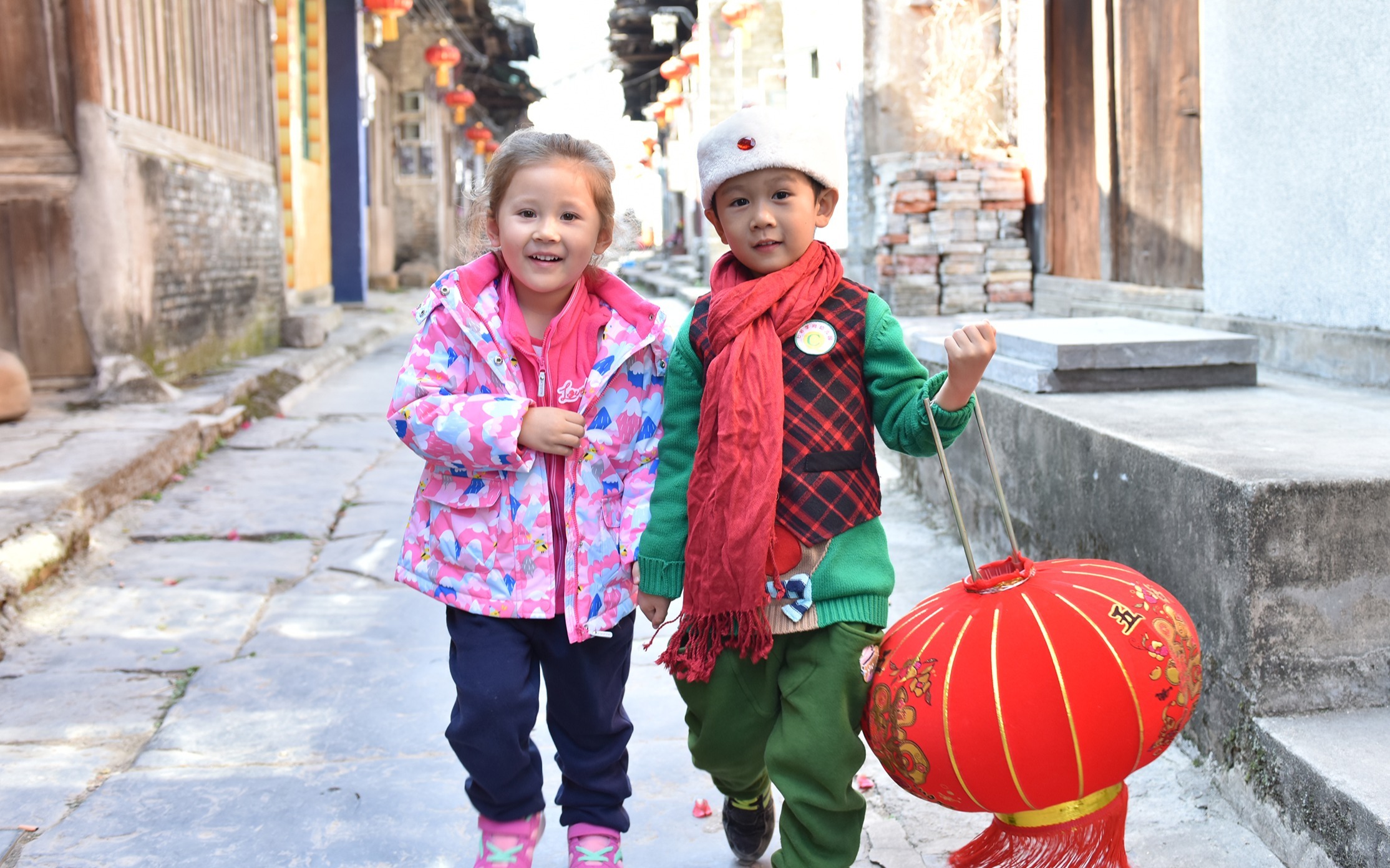
- 8-Day Beijing–Xi'an–Shanghai Private Tour
- 9-Day Beyond the Golden Triangle
- 10-Day Lanzhou–Xiahe–Zhangye–Dunhuang–Turpan–Urumqi Tour
- 11-Day Classic Wonders
- 11-Day Family Happiness
- 12-Day China Silk Road Tour from Xi'an to Kashgar
- 12-day Panda Keeper and Classic Wonders
- 12-Day Shanghai, Huangshan, Hangzhou, Guilin and Hong Kong Tour
- 13-Day Beijing–Xi'an–Dunhuang–Urumqi–Shanghai Tour
- 14-Day China Natural Wonders Discovery
- 2-Week Riches of China
- 3-Week Must-See Places China Tour Including Holy Tibet
- How to Plan Your First Trip to China 2024/2025 — 7 Easy Steps
- How to Plan Your First-Time Family Trip to China
- Best (& Worst) Times to Visit China, Travel Tips (2024/2025)
- One Week in China - 4 Time-Smart Itineraries
- How to Plan a 10-Day Itinerary in China (Best 5 Options)
- Top 4 China Itinerary Options in 12 Days (for First Timers) 2024/2025
- 2-Week China Itineraries: Where to Go & Routes (2024)
- 17-Day China Itineraries: 4 Unique Options
- How to Spend 19 Days in China in 2024/2025 (Top 5 Options and Costs)
- How to Plan a 3-Week Itinerary in China: Best 3 Options (2024)
- China Itineraries from Hong Kong for 1 Week to 3 Weeks
- China Weather in January 2024: Enjoy Less-Crowded Traveling
- China Weather in March 2024: Destinations, Crowds, and Costs
- China Weather in April 2024: Where to Go (Smart Pre-Season Pick)
- China Weather in May 2024: Where to Go, Crowds, and Costs
- China Weather in June 2024: How to Benefit from the Rainy Season
- China Weather in July 2024: How to Avoid Heat and Crowds
- China Weather in August 2024: Weather Tips & Where to Go
- China Weather in September 2024: Weather Tips & Where to Go
- China Weather in October 2024: Where to Go, Crowds, and Costs
- China Weather in November 2024: Places to Go & Crowds
- China Weather in December 2024: Places to Go and Crowds
Get Inspired with Some Popular Itineraries
More travel ideas and inspiration, sign up to our newsletter.
Be the first to receive exciting updates, exclusive promotions, and valuable travel tips from our team of experts.
Why China Highlights
Where can we take you today.
- Southeast Asia
- Japan, South Korea
- India, Nepal, Bhutan, and Sri lanka
- Central Asia
- Middle East
- African Safari

- Travel Agents
- Loyalty & Referral Program
- Privacy Policy

Address: Building 6, Chuangyi Business Park, 70 Qilidian Road, Guilin, Guangxi, 541004, China

- Skip to primary navigation
- Skip to main content
- Skip to primary sidebar
- Skip to footer
StoryLearning
Learn A Language Through Stories
Chinese New Year: The Ultimate Guide For Chinese Learners
If you're learning Chinese then I'm sure you've heard of Chinese New Year. It's the most eagerly awaited date in the Chinese calendar. And it's also the most famous and recognisable Chinese festival around the world.
However, beyond vague impressions of firecrackers, lion dances and lots of red decorations, many non-Chinese have little idea about the history or traditions of this key element of Chinese culture and identity.
So for anyone who wants to learn more, here’s my brief introduction to Chinese New Year, what it means and what the Chinese do to mark it.
By the way, if you want to learn Chinese fast and have fun, my top recommendation is Chinese Uncovered which teaches you through StoryLearning®.
With Chinese Uncovered you’ll use my unique StoryLearning® method to learn Chinese through story…not rules. It’s as fun as it is effective. If you’re ready to get started, click here for a 7-day FREE trial.
Chinese New Year: An Overview
Every year, sometime in January or February, the greatest movement of people on the planet begins as migrant workers throughout China begin the journey back to their hometowns to celebrate Chinese New Year with their families.
Usually known as 春节 chūnjié (Spring Festival) in China – and either “Chinese New Year” or “Lunar New Year” in other parts of the world – the festival is a time for family reunions, feasting and paying respects while seeing out the old year and welcoming in the new.
It is, without doubt, among the most important festivals in the Chinese calendar. And the celebrations involve various ancient traditions that date back millennia combined with more modern customs that have been incorporated more recently.
In many ways, Chinese New Year can be seen as being similar to Christmas in Western countries – or Thanksgiving in the US – when people have time off work and travel back to spend time with their loved ones.
Like Christmas or Thanksgiving, Chinese New Year is celebrated differently in different regions. And the traditions kept also vary from family to family.
Many of the older practices are derived from Confucianism, Buddhism or Taoism.
However, today it is also seen simply as a joyous occasion when people can spend time with those closest to them as they look forward with hope and optimism to a successful and prosperous new year.
Now let’s look at some of the various aspects of the celebrations in more detail.
When Is Chinese New Year?
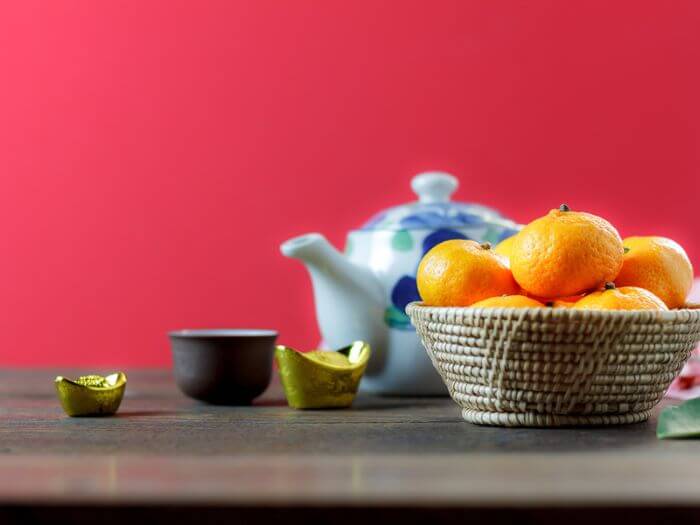
The date of Chinese New Year is determined by the Chinese lunisolar calendar, which divides the year into 24 solar terms, making up 12 lunar months.
According to the Chinese calendar, the winter solstice falls in the 11 th lunar month – and in practice, Chinese New Year usually falls on the second new moon after the winter solstice.
This means Chinese New Year’s Day is almost always celebrated on the day of the new moon closest to the start of the first lunisolar period of the year, the period known as 立春 lìchūn (Start of Spring).
This also corresponds to the first full moon after the final lunisolar period of the year, known as 大寒 dàhān (Big Cold).
Due to the way the lunar calendar is calculated, other dates are possible, but if all this seems a little complicated, a quick Google will tell you the correct date for any particular year – which is a much easier way to work it out!
In any case, on the Gregorian (Western) calendar, Chinese New Year always falls between 21 st January and 20 th February.
A Little History Of Chinese New Year
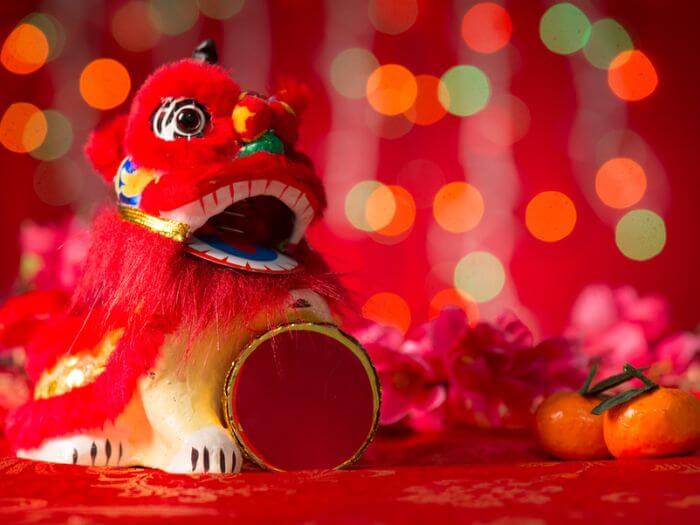
The start of the new lunisolar year has been celebrated in some form for several thousand years dating back at least to the Warring States period (475 – 221 BCE).
After this, the practice then spread throughout China thanks to the unification of the country under the Qin dynasty (221 – 206 BCE).
From the Han dynasty (202 BCE – 220 CE), celebrations involving ancestor worship, visiting family and wishing each other a happy new year were all recorded, customs that continue to this day.
The tradition of celebrations lasting until sunrise, known as 守岁 shŏusuì , dates back to the time of the Jin dynasty (266 – 420 CE), as does the first use of the term 除夕 chúxī to refer to Chinese New Year’s Eve.
By the Tang dynasty (618 – 907 CE), the practice of burning bamboo to make it explode had developed.
Later, after its invention in China sometime during the ninth century, gunpowder was placed inside the bamboo to create a bigger bang. And this is the precursor of today’s tradition of setting off firecrackers.
Indeed, one common Chinese word still used for “firecrackers” is 爆竹 bàozhú , which literally means “exploding bamboo”.
Since then, Chinese New Year traditions have continued to evolve. And celebrations today combine these ancient customs with several more modern ones.
The Cultural Revolution And Its Legacy
One other important development to note came during the Cultural Revolution of the 1960s and 70s under Chairman Mao when Chinese New Year celebrations were banned in Mainland China.
They were once again permitted from 1980, but the legacy of this hiatus is that, in many ways, the celebrations held by overseas Chinese communities in places like Malaysia or Singapore are now more traditional than those in Mainland China.
15 Days Of Chinese New Year Celebrations
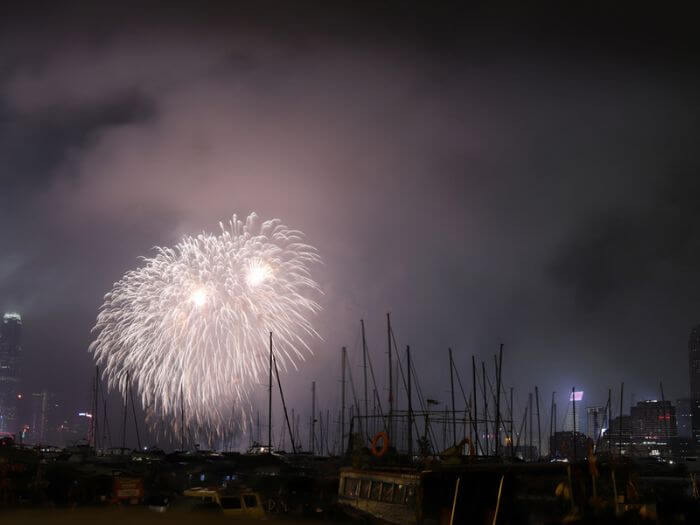
Although the most important dates of Chinese New Year are New Year’s Eve and New Year’s Day, the celebrations traditionally last 15 days, with each day having a special name and associated activities.
The first day of the new year is known as 春节 chūnjié , Spring Festival, and this is the day for setting off firecrackers, gathering with the extended family, exchanging red envelopes and other such customs.
After this, each of the following days has specific activities associated with it.
For example, the second day is known as 开年 kāinián (Year’s Beginning), and was traditionally the time for married daughters to visit their birth families.
On this day, beggars would also walk the streets with a picture of the god of wealth, 财神 cáishén , shouting 财神到 cáishéndào , meaning “the god of wealth has come”. They would then be rewarded with money for their efforts.
The 15 th day is known as 元宵节 yuánxiāojié , the Lantern Festival, and it marks the end of the Chinese New Year period.
On this day, it's traditional to eat 汤圆 tāngyuán , glutinous rice balls containing fillings such as sweet red bean paste, black sesame paste, peanut paste – or, more recently, things like chocolate or custard.
Chinese New Year Traditions
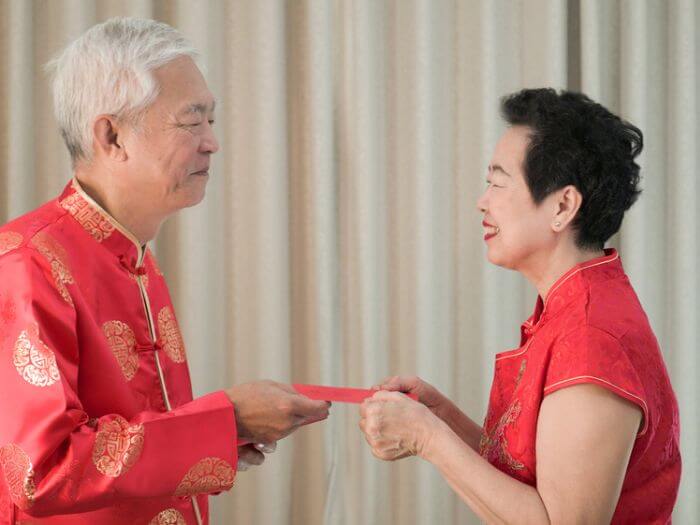
Now let’s have a look at some of the various traditions that comprise Chinese New Year celebrations and where they come from.
Cleaning The House
Before the New Year arrives, one tradition is to clean the house to sweep away the bad luck from the previous year, preparing the way for good fortune in the year to come.
After cleaning, dustpans and brooms must be put away so the newly arrived good luck will not be swept away too.
Ancestor Worship
Ancestor worship has always been a part of Chinese New Year, and even to this day, it is customary to pay respects to one’s ancestors on Chinese New Year’s Eve.
However, whether this tradition is kept – and how formally or ritualistically it is done – depends on each family and their beliefs.
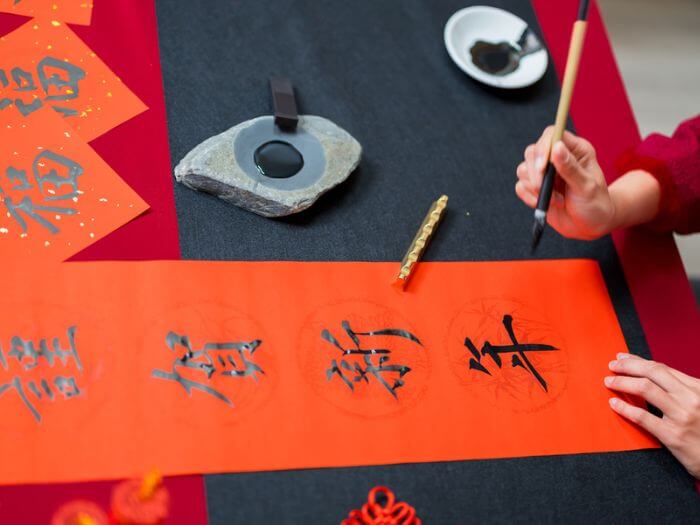
Along with the worship of ancestors, Chinese New Year is also a time to clean altars and worship and propitiate the various gods of the home.
Of these, among the most important is the Kitchen God, 灶君 zāo jūn , who flies back to heaven just before the New Year to report on the family to the Jade Emperor, 玉皇 yù huáng , the principal Chinese god of the heavens.
As a result, the Kitchen God is given ‘bribes’, and his lips are smeared with honey to sweeten his words in an attempt to ensure his report is favourable.
Firecrackers are let off to hasten his arrival in heaven, and his statue is then burnt. Afterwards, a new one is put in its place on New Year’s Day.
Again, the extent to which people follow these traditions nowadays varies from family to family.
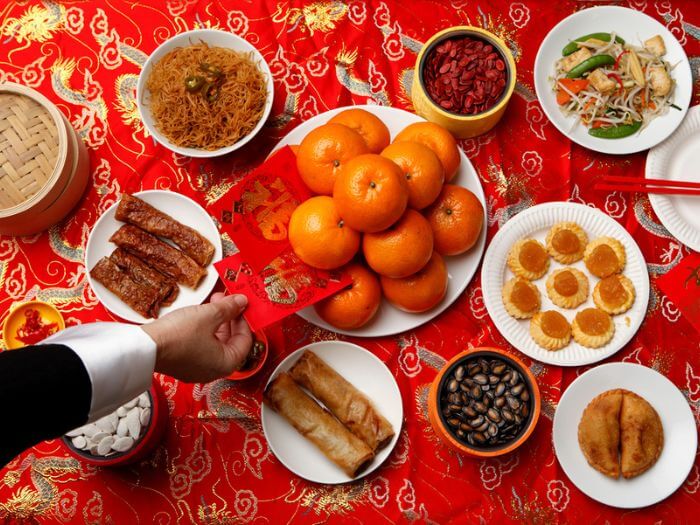
Superstitions
Many superstitions about what you can and can’t do around the time of Chinese New Year exist.
It’s considered bad luck to have your hair cut after New Year since the Chinese character for “hair” 发 fà is the same as 发 fā , which can mean “make a fortune” – so cutting your hair represents cutting your fortune.
According to one traditional practice, after letting off firecrackers on New Year’s Eve, the door to the house is sealed and must remain closed until it is ritually opened again the next day. This is thought to prevent evil spirits from entering the house.
Debts must be paid before the New Year, including debts of gratitude, which is one reason why gifts are exchanged at this time.
If anybody breaks plates or swears on Chinese New Year’s Day, certain expressions must be uttered to appease the gods.
As mentioned above, sweeping is not allowed because it might sweep away any newly-arrived good luck, and lighting fires is also forbidden, so all food needs to be cooked before midnight on New Year’s Eve.
Firecrackers & Fireworks
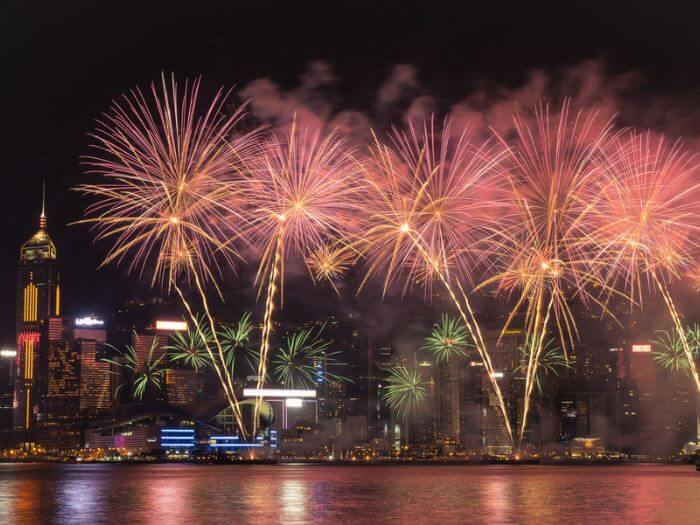
An integral part of the celebrations involves the setting off of firecrackers and fireworks, and this dates back to some of the very earliest traditions surrounding Chinese New Year.
According to an ancient legend, a type of mythical beast called a nian used to terrorise villages at the start of the new year, appearing at night to eat the villagers – especially the children.
However, one year, an old man told his village that he would stay up to fight off the nian , and to do this, he put up red papers everywhere and armed himself with firecrackers.
The next morning, the man was still there, and nobody had been eaten – the man had saved the village because he had discovered that nian were afraid of loud noises and the colour red.
As a result, to this day, Chinese people let off firecrackers and fireworks to drive away evil spirits.
In the past, at midnight on New Year’s Eve, Chinese cities were lit up by thousands of fireworks as people went into the streets to let off their own personal stash.
Things have changed though, and in recent years, places like Beijing and Shanghai have banned individuals from letting off fireworks, providing an official firework display instead.
However, while the official display may be technically far superior – while reducing pollution and the risk of fire – it will never match the spectacular sight of the skies above the capital being lit up by innumerable fireworks being spontaneously let off from every street.
Lion dances are performed, accompanied by the loud banging of drums, which is also related to driving away the evil nian .
Nowadays, lion dances are arguably easier to see in overseas Chinese communities than on the mainland.
Reunion Dinner And Food
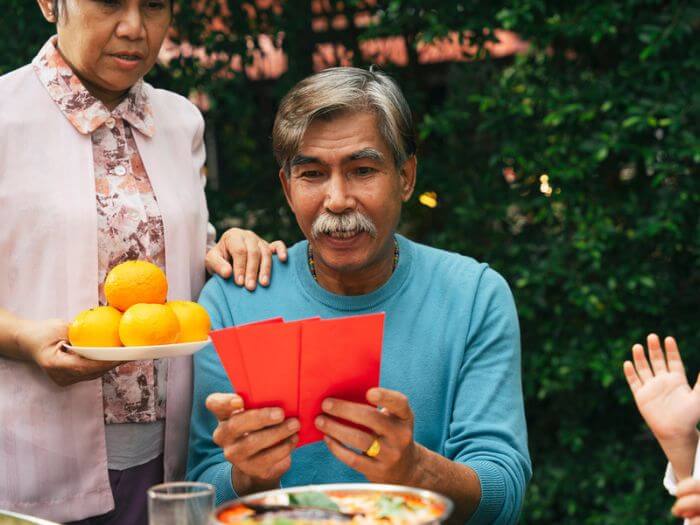
A major part of the celebrations for each family is the reunion dinner, a lavish feast for which people return to their hometowns from all over the country.
A range of traditional dishes is served at the reunion dinner, each with its own special meaning. Here are some examples:
One of the most important elements of the feast is a fish dish, and this is because the Chinese word for fish, 鱼 yú , is pronounced exactly the same as 余 yú , meaning “surplus”.
In Chinese, the blessing 年年有余 nián nián y ǒ u yú (every year may there be a surplus), sounds the same as 年年有鱼 nián nián y ǒ u yú (every year may there be fish) – so eating fish for the New Year’s feast is considered auspicious.
To represent the surplus, some of the fish is eaten but not all of it – and the remainder, the ‘surplus’, is saved for the next day.
In the north of China, another important culinary element is 饺子 jiăozi (Chinese dumplings). This is because the shape of jiaozi is thought to resemble a 元宝 yuánbăo , a traditional gold or silver ingot, so making and eating them represents prosperity.
Often, families will sit down together to 包饺子 bāo jiăozi (wrap dumplings) before eating them at around midnight sometime after the main meal.
Auspicious ingredients are often included in the fillings, and sometimes a coin is placed inside one dumpling. The person who later finds the coin is then guaranteed good luck for the rest of the year.
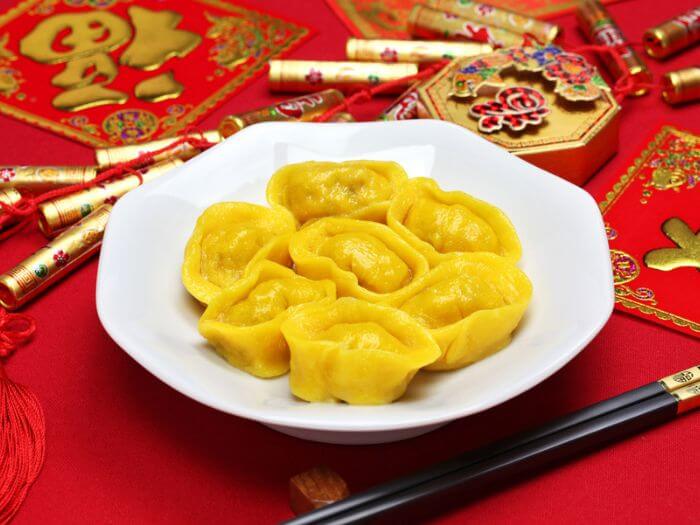
In eastern China in Shanghai and the provinces of Zhejiang and Jiangsu, people eat 年糕 niángāo , a type of New Year cake. The pronunciation is the same as 年高 niángāo, literally “year high”, which means “prosperous year”.
Other Chinese New Year Foods
These are just three of the traditional foods served during the reunion dinner, but there are many more, depending on the region.
Foods are often chosen because their names sound auspicious. One other example is 苹果 pínggu ǒ (apples), which are eaten because the first syllable sounds like 平 píng (peace).
Similarly, mandarins are eaten in southern China because their name sounds like “luck” in some Teochew dialects .
Decorations
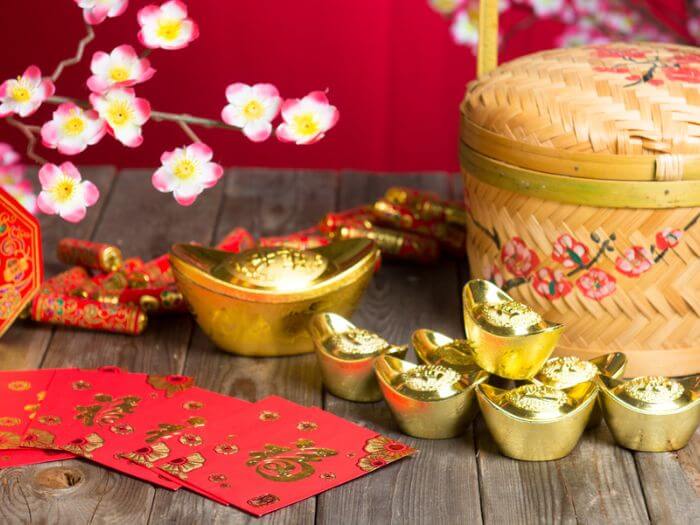
During Chinese New Year, people adorn their houses with traditional decorations.
Most people will be familiar with red lanterns, which are related to scaring away the mythical nian monsters that are afraid of the colour red. This is why red is also the predominant colour for all other traditional Chinese New Year decorations.
Another ubiquitous decoration is New Year couplets, known as 春联 chūnlián , which are hung on either side of a house’s door.
Couplets consist of two lines of poetry, and those chosen for New Year’s decorations usually express hope, happiness or optimism for the year to come.
The Chinese character 福 fú , meaning “good fortune”, “happiness” or “blessing”, is often placed in the middle of the door between the couplets or in other places around the house
However, the 福is usually hung upside-down, and this is because the Chinese word for “upside-down” is 倒 dào .
This word is pronounced the same as 到 dào , meaning “arrive”, so in Chinese, if you say 福倒 fúdào (fu upside-down), it sounds the same as福到 fúdào (good fortune arrives), which is seen as a way of inviting blessings upon the household.
Finally, cute representations of the Chinese zodiac animal for the year to come are also a popular decorative element seen in homes and shops everywhere.
Red Envelopes
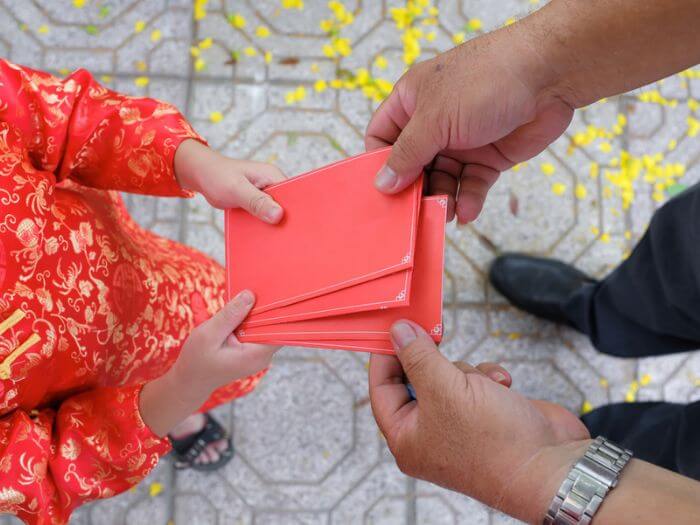
An important New Year tradition is the giving of 红包 hóngbāo , or “red envelopes”, containing lucky money.
They are usually given by married members of a family to children and teenagers, and the custom is to give an amount of money ending in figures that are considered auspicious.
For example, 八 bā (8) is considered among the luckiest Chinese numbers since the pronunciation is close to the 发 in 发财 fācái , which means “get rich”. However, 四 sì (4) should be avoided due to its similarity to the word 死 sĭ , meaning “die”.
The practice of giving red envelopes comes from a legend that tells of an evil spirit called a 祟 suì that would pat the head of sleeping children on New Year’s Eve, after which the children would grow up to be learning disabled.
One New Year’s Eve, a couple tried to prevent their child from sleeping by giving him eight coins to play with. However, the child still fell asleep, so they placed the coins in a red envelope under his pillow.
Later that night, the sui appeared, but when it was about to pat the boy’s head, it saw the glint of the shining coins and was frightened away.
For this reason, money in red envelopes is sometimes called 压岁钱 yāsuìqián , which derives from 压祟钱 yāsuìqián , meaning “money to drive away the sui “.
Spring Festival Gala
A more modern tradition in Mainland China is the Spring Festival Gala, a TV variety show featuring music, dance, comedy and drama sketches – along with a good dose of fairly overt nationalistic propaganda.
It's broadcast on Chinese New Year’s Eve in China and around the world. Most families will gather around the television to watch it together – or at least have it on in the background – and as a result, it has become the world’s most watched broadcast.
You can find previous editions on YouTube if you want to check it out – and it’s also streamed live on YouTube each year.
New Year’s Songs
Just as Christmas in the West is associated with festive songs, Chinese New Year also has its own collection of classics that you’ll hear everywhere during the Chinese New Year period in China and other countries that celebrate the festival.
If you want to listen to some, go onto YouTube and search for ‘Spring Festival music’ to find countless compilations of all the best-known tunes.
Temple Fairs
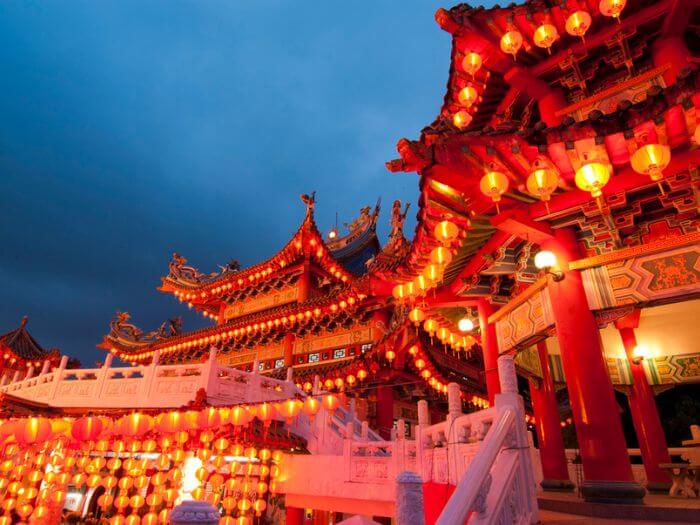
Temple fairs, known as 庙会 miáohuì in Chinese, are held during the Chinese New Year period.
Originally, they were intended for worshipping the gods and asking for blessings – and this still happens – but nowadays, temple fairs, especially in northern China, are vibrant affairs with street food, fairground-style games, markets and more.
For example, if you are in Beijing at the right time of year, many of the city’s temples host lively fairs, and they shouldn’t be missed.
Inside, you can wander around the temple grounds sampling a range of tasty snacks such as 冰糖葫芦 bīngtánghúlù (fruit such as Chinese hawthorn dipped in maltose, which then hardens), barbecued pigeon or classic Beijing串儿 chuànr (barbecued skewers of meat).
Alternatively, if you’re feeling brave, you might have the opportunity to taste bugs, scorpions or tarantulas on sticks, all of which are sold for their dubious medicinal properties. Or perhaps just for the shock factor.
Useful Chinese New Year Phrases
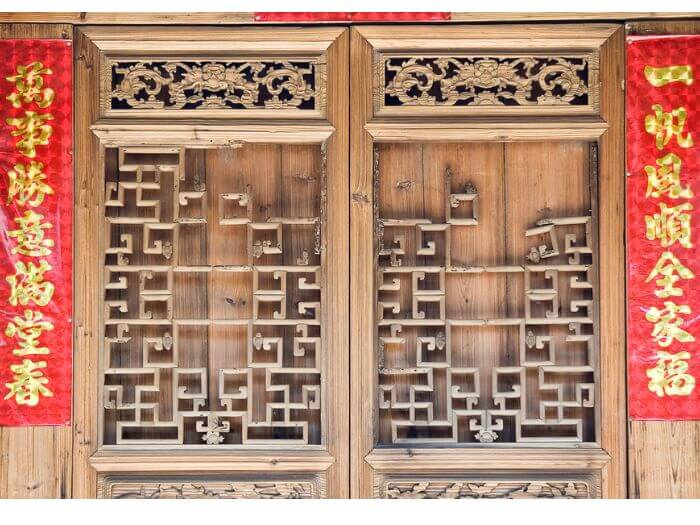
Here are a few of the most important words and expressions related to Chinese New Year.
- 春节 chūnjié (Spring Festival), technically the first day of the Chinese New Year.
- 新年快乐 xīn nián kuài le (Happy New Year), a modern way to say this influenced by the English expression.
- 恭喜发财 gōngxĭ fācái (Have a prosperous new year), one of the most popular and well-known traditional New Year’s greetings. Literally, it means “congratulations, make a fortune” – the ‘congratulations’ part relates to congratulating people for surviving another difficult year.
- 年年有余 nián nián y ǒ u yú (May there be an abundance every year). This greeting is pronounced in exactly the same way as if you say “may there be fish every year”, which is why a fish dish is considered an essential part of the New Year’s feast.
- 财神到 cáishéndào (The god of wealth has arrived). You will often hear this in well-known Chinese New Year songs.
- 红包 hóngbāo (Red envelopes) containing money that are usually given to children and teenagers.
- 饺子 jiăozi (jiaozi – or Chinese dumplings) – that are traditionally eaten on New Year’s Eve in the north of China.
- 年糕 niángāo (New Year’s cake), traditionally eaten in Shanghai as well as Zhejiang and Jiangsu provinces.
- 爆竹 bàozhú (A common word for firecrackers).
- 鞭炮 biānpào (Strings of firecrackers that are set off together to make lots of noise and frighten off evil spirits).
- 守岁 sh ǒ usuì (The practice of staying up till sunrise to welcome in the new year).
- 除夕 chúxī (Chinese New Year’s Eve).
- 庙会 miàohuì (Temple fair).
A Vibrant And Enjoyable Festival
Chinese New Year is one of the key dates in the Chinese calendar, and celebrating it is an important part of what it is to be Chinese.
It’s also an extremely vibrant and enjoyable festival. And if you ever have the chance to celebrate it in China or another country with a large Chinese population, it’s sure to be a memorable experience.
In the meantime, if you're looking for the best way to learn Chinese, why not apply the rules of StoryLearning and read books in Chinese ?
Language Courses
- Language Blog
- Testimonials
- Meet Our Team
- Media & Press
Download this article as a FREE PDF ?
What is your current level in Swedish?
Perfect! You’ve now got access to my most effective [level] Swedish tips…
Where shall I send the tips and your PDF?
We will protect your data in accordance with our data policy.
What is your current level in Danish?
Perfect! You’ve now got access to my most effective [level] Danish tips…
NOT INTERESTED?
What can we do better? If I could make something to help you right now, w hat would it be?
Which language are you learning?
What is your current level in [language] ?
Perfect! You’ve now got access to my most effective [level] [language] tips, PLUS your free StoryLearning Kit…
Where shall I send them?

Download this article as a FREE PDF?
Great! Where shall I send my best online teaching tips and your PDF?
Download this article as a FREE PDF ?
What is your current level in Arabic?
Perfect! You’ve now got access to my most effective [level] Arabic tips…
FREE StoryLearning Kit!
Join my email newsletter and get FREE access to your StoryLearning Kit — discover how to learn languages through the power of story!
Download a FREE Story in Japanese!
Enter your email address below to get a FREE short story in Japanese and start learning Japanese quickly and naturally with my StoryLearning® method!
What is your current level in Japanese?
Perfect! You’ve now got access to the Japanese StoryLearning® Pack …
Where shall I send your download link?
Download Your FREE Natural Japanese Grammar Pack
Enter your email address below to get free access to my Natural Japanese Grammar Pack and learn to internalise Japanese grammar quickly and naturally through stories.
Perfect! You’ve now got access to the Natural Japanese Grammar Pack …
What is your current level in Portuguese?
Perfect! You’ve now got access to the Natural Portuguese Grammar Pack …
What is your current level in German?
Perfect! You’ve now got access to the Natural German Grammar Pack …
Train as an Online Language Teacher and Earn from Home
The next cohort of my Certificate of Online Language Teaching will open soon. Join the waiting list, and we’ll notify you as soon as enrolment is open!
Perfect! You’ve now got access to my most effective [level] Portuguese tips…
What is your current level in Turkish?
Perfect! You’ve now got access to my most effective [level] Turkish tips…
What is your current level in French?
Perfect! You’ve now got access to the French Vocab Power Pack …
What is your current level in Italian?
Perfect! You’ve now got access to the Italian Vocab Power Pack …
Perfect! You’ve now got access to the German Vocab Power Pack …
Perfect! You’ve now got access to the Japanese Vocab Power Pack …
Download Your FREE Japanese Vocab Power Pack
Enter your email address below to get free access to my Japanese Vocab Power Pack and learn essential Japanese words and phrases quickly and naturally. (ALL levels!)
Download Your FREE German Vocab Power Pack

Enter your email address below to get free access to my German Vocab Power Pack and learn essential German words and phrases quickly and naturally. (ALL levels!)
Download Your FREE Italian Vocab Power Pack
Enter your email address below to get free access to my Italian Vocab Power Pack and learn essential Italian words and phrases quickly and naturally. (ALL levels!)
Download Your FREE French Vocab Power Pack
Enter your email address below to get free access to my French Vocab Power Pack and learn essential French words and phrases quickly and naturally. (ALL levels!)
Perfect! You’ve now got access to the Portuguese StoryLearning® Pack …
What is your current level in Russian?
Perfect! You’ve now got access to the Natural Russian Grammar Pack …
Perfect! You’ve now got access to the Russian StoryLearning® Pack …
Perfect! You’ve now got access to the Italian StoryLearning® Pack …
Perfect! You’ve now got access to the Natural Italian Grammar Pack …
Perfect! You’ve now got access to the French StoryLearning® Pack …
Perfect! You’ve now got access to the Natural French Grammar Pack …
What is your current level in Spanish?
Perfect! You’ve now got access to the Spanish Vocab Power Pack …
Perfect! You’ve now got access to the Natural Spanish Grammar Pack …
Perfect! You’ve now got access to the Spanish StoryLearning® Pack …
Where shall I send them?
What is your current level in Korean?
Perfect! You’ve now got access to my most effective [level] Korean tips…
Perfect! You’ve now got access to my most effective [level] Russian tips…
Perfect! You’ve now got access to my most effective [level] Japanese tips…
What is your current level in Chinese?
Perfect! You’ve now got access to my most effective [level] Chinese tips…
Perfect! You’ve now got access to my most effective [level] Spanish tips…
Perfect! You’ve now got access to my most effective [level] Italian tips…
Perfect! You’ve now got access to my most effective [level] French tips…
Perfect! You’ve now got access to my most effective [level] German tips…
Download Your FREE Natural Portuguese Grammar Pack
Enter your email address below to get free access to my Natural Portuguese Grammar Pack and learn to internalise Portuguese grammar quickly and naturally through stories.
Download Your FREE Natural Russian Grammar Pack
Enter your email address below to get free access to my Natural Russian Grammar Pack and learn to internalise Russian grammar quickly and naturally through stories.
Download Your FREE Natural German Grammar Pack
Enter your email address below to get free access to my Natural German Grammar Pack and learn to internalise German grammar quickly and naturally through stories.
Download Your FREE Natural French Grammar Pack
Enter your email address below to get free access to my Natural French Grammar Pack and learn to internalise French grammar quickly and naturally through stories.
Download Your FREE Natural Italian Grammar Pack
Enter your email address below to get free access to my Natural Italian Grammar Pack and learn to internalise Italian grammar quickly and naturally through stories.
Download a FREE Story in Portuguese!

Enter your email address below to get a FREE short story in Brazilian Portuguese and start learning Portuguese quickly and naturally with my StoryLearning® method!
Download a FREE Story in Russian!
Enter your email address below to get a FREE short story in Russian and start learning Russian quickly and naturally with my StoryLearning® method!
Download a FREE Story in German!
Enter your email address below to get a FREE short story in German and start learning German quickly and naturally with my StoryLearning® method!
Perfect! You’ve now got access to the German StoryLearning® Pack …
Download a FREE Story in Italian!
Enter your email address below to get a FREE short story in Italian and start learning Italian quickly and naturally with my StoryLearning® method!
Download a FREE Story in French!

Enter your email address below to get a FREE short story in French and start learning French quickly and naturally with my StoryLearning® method!
Download a FREE Story in Spanish!
Enter your email address below to get a FREE short story in Spanish and start learning Spanish quickly and naturally with my StoryLearning® method!
FREE Download:
The rules of language learning.

Enter your email address below to get free access to my Rules of Language Learning and discover 25 “rules” to learn a new language quickly and naturally through stories.
What can we do better ? If I could make something to help you right now, w hat would it be?
What is your current level in [language]?
Perfect! You’ve now got access to my most effective [level] [language] tips…
Download Your FREE Spanish Vocab Power Pack

Enter your email address below to get free access to my Spanish Vocab Power Pack and learn essential Spanish words and phrases quickly and naturally. (ALL levels!)
Download Your FREE Natural Spanish Grammar Pack
Enter your email address below to get free access to my Natural Spanish Grammar Pack and learn to internalise Spanish grammar quickly and naturally through stories.
Free Step-By-Step Guide:
How to generate a full-time income from home with your English… even with ZERO previous teaching experience.
What is your current level in Thai?
Perfect! You’ve now got access to my most effective [level] Thai tips…
What is your current level in Cantonese?
Perfect! You’ve now got access to my most effective [level] Cantonese tips…
Steal My Method?
I’ve written some simple emails explaining the techniques I’ve used to learn 8 languages…
I want to be skipped!
I’m the lead capture, man!
Join 84,574 other language learners getting StoryLearning tips by email…
“After I started to use your ideas, I learn better, for longer, with more passion. Thanks for the life-change!” – Dallas Nesbit
Perfect! You’ve now got access to my most effective [level] [language] tips…
Perfect! You’ve now got access to my most effective [level] [language] tips…
Join 122,238 other language learners getting StoryLearning tips by email…
Find the perfect language course for you.
Looking for world-class training material to help you make a breakthrough in your language learning?
Click ‘start now’ and complete this short survey to find the perfect course for you!
Do you like the idea of learning through story?
Do you want…?
- China Tours
- Tailor-made
+86 015977325784 [email protected] Mon-Fri 9am - 6pm China Time
- Destinations
- Seniors Pace
- World Heritage
- Zhangjiajie
- Inner Mongolia
- Plan My Asia Trip
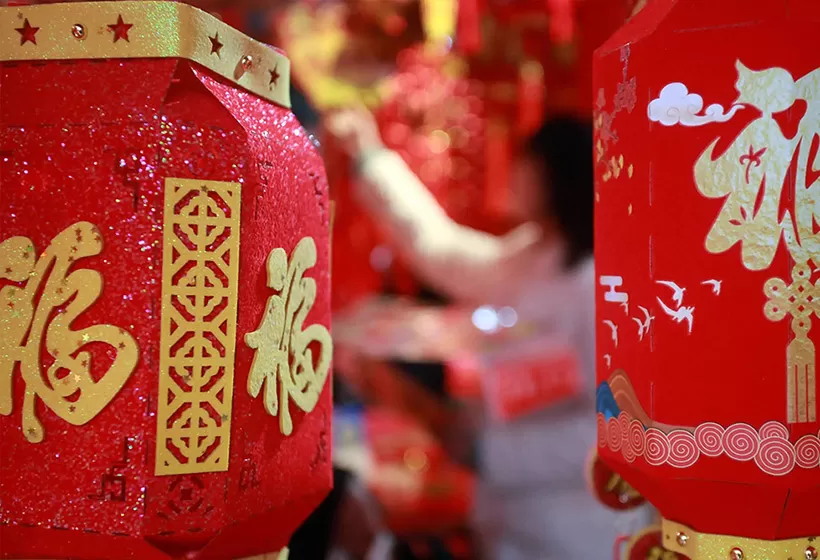
Traditional Chinese New Year - Chun Jie

- 01. Step 1: Where to go in China
- 02. Step 2: When to go in China
- 03. Step 3: How to Visit Tibet in 2021 — Suggestions and
- Names: Spring Festival
- Chinese : 春节 / chūn jié
- When : end of January or beginning of February
- Activities : Pasting couplets, staying up all night to see the new year in, Bainian (pay a New Year call), lucky money, sacrifices, lion dance, dragon dance, etc.
- Holiday : 7 days,
- Travel tips : The Spring Festival is a good time to experience traditional Chinese culture, and it is also the peak time for tourism. Many people choose to celebrate the Spring Festival while traveling. Most southerners like to travel by car. Therefore, hotel prices in southern cities will rise during the Spring Festival, which is similar to the Mid-Autumn Festival .
Introduction to Traditional Chinese New Year
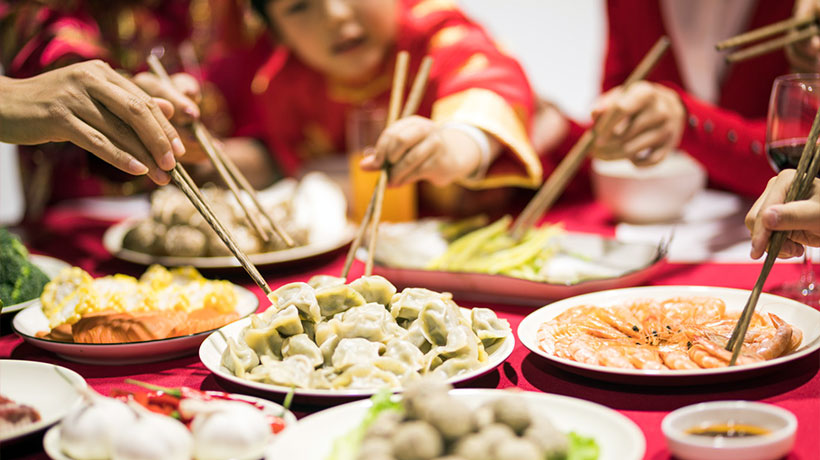
The Chinese New Year, also called Spring Festival, is the most important and widely celebrated festival of all in China. It is celebrated from the 1st day of the 1st lunar month to the 15th day of the 1st lunar month. The final (15th) day is called Lantern Festival, and the night before the 1st day is called Chinese New Year's Eve (Chuxi in Chinese pinyin). This is a time for family reunions, visiting relatives and friends and exchanging greetings for the coming New Year. It is also a time to ring out the old and ring in the new. The Chinese New Year can also be called "Guonian" which means the passing of the old year to the new one. This festival emphasizes the importance of family ties. The dinner gathering on Chinese New Year's Eve is the most important family occasion of the year.
Lunar New Year Calendar and holiday
The traditional Chinese New Year holiday is 7 days, starting from the first day of New Year's Eve to the seventh day, with work starting on the eighth day. If you love Chinese New Year culture, this is the best time to visit China.
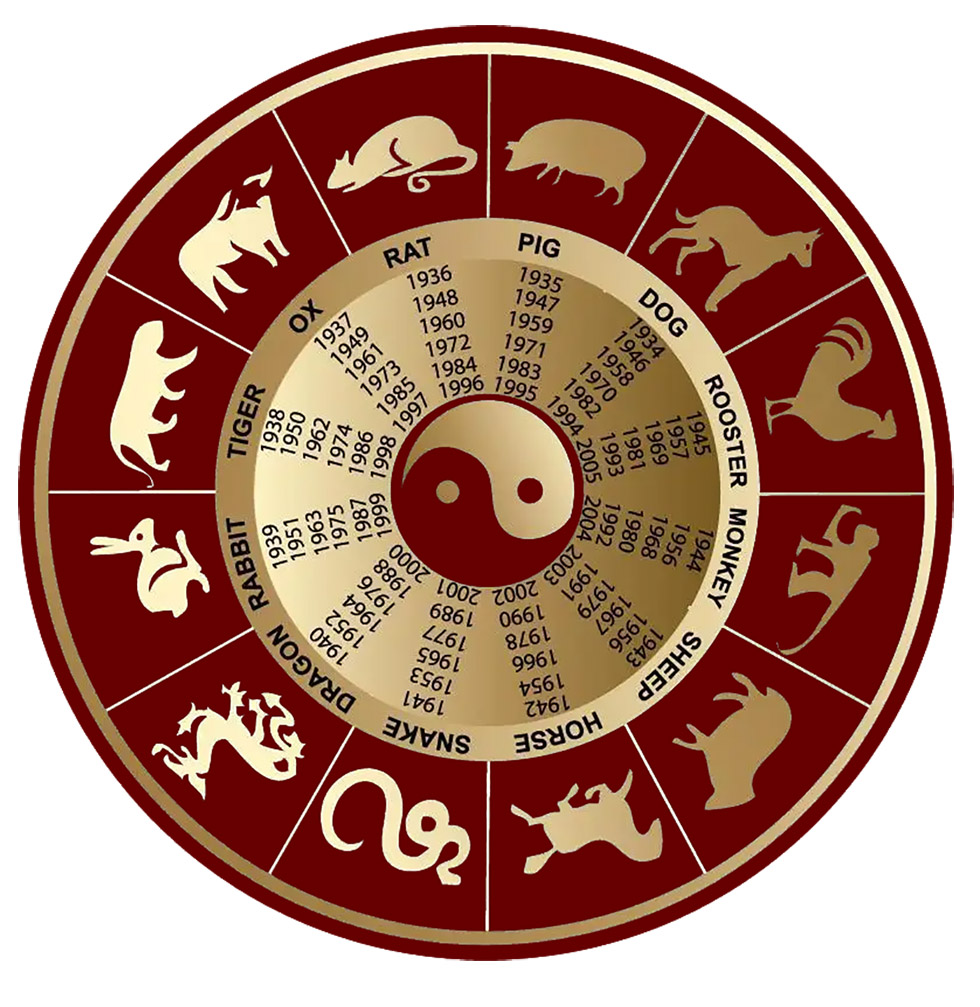
Note : The tiger is followed by the rabbit, and the cycle continues.
- Avoid the busiest China holidays while planning your China travel
The Origin of Chinese New Year
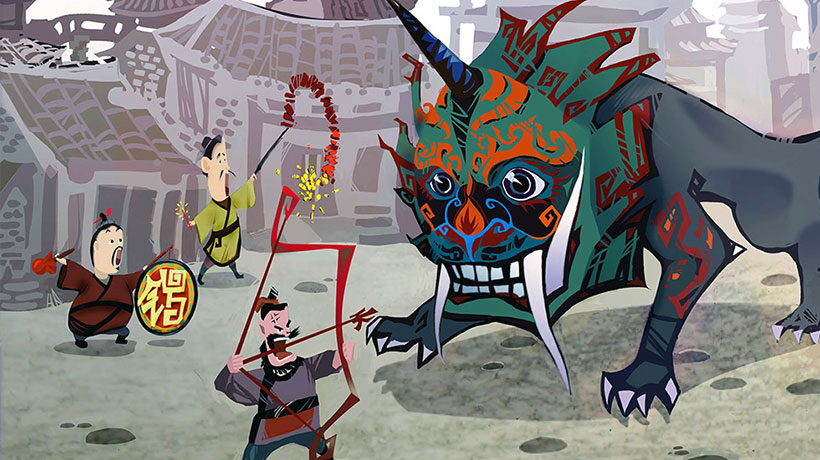
There are several versions of the origin of the Chinese New Year. The most widely heard one is that there was a mythical beast called "Nian" which means "year" in Chinese. Nian always came on the first day of New Year to prey on livestock, crops, and even people. In order to protect themselves, people started putting food in front of their doors at the beginning of every New Year, as they believed that after Nian ate the food prepared for him, he wouldn't eat any of their crops and people. Coincidentally, some people once saw that Nian was scared away by the red clothes worn by a child so they concluded that Nian was afraid of the color red. Therefore, in preparation for the New Year, people began buying new red clothes. Also, they hung red lanterns and red spring couplets on doors and windows. They also lit firecrackers to scare Nian away. From then on, Nian never came back again.
This tradition has been handed down through generations. People still buy many red items in preparation for the New Year: red clothes, red lanterns, red paper cuttings, red spring couplets, red fireworks and firecrackers, and all manner of red objects. So now you know that people don't just feel the color red is exciting or festive, they have a reason to do that!
Related cultural activities you may like
- Learn traditional Chinese calligraphy in Xi'an >>
Symbolic Cuisines of Chinese New Year
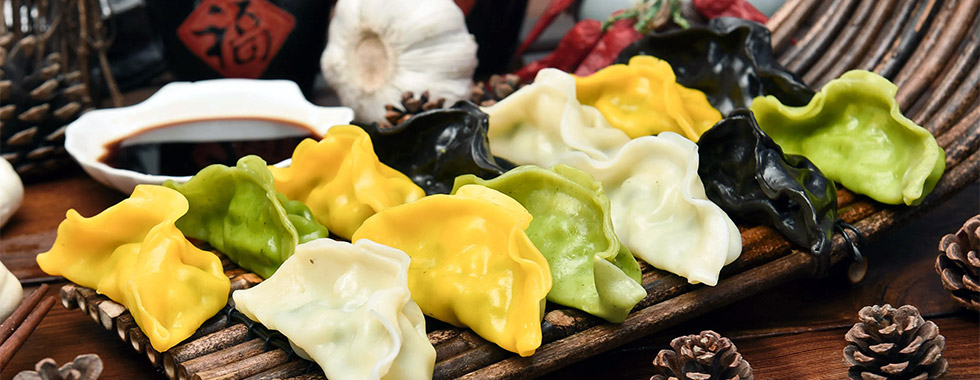
On Chinese New Year's Eve, members of the family, big or small, near or far away, gather for a "reunion dinner". The most common dishes for this dinner are chicken and fish. There are many symbolic foods prepared for the New Year. For example, the fish, "yu" in Chinese pinyin, signifies that there should always be surpluses. Commonly in northern China, "Jiaozi" (dumplings) are made, symbolizing the luck that is wrapped inside. In eastern China, "Nian gao" (Chinese New Year Pudding) is prepared, symbolizing a more prosperous year. People also buy melon seeds, candy, and other seeds.
- Make dumplings in a local home >>
Top Common Practices of Chinese New Year
A few days before the New Year, every corner of the house must be swept and cleaned. This is to wipe away the old and evil spirits. Then, on the eve of the New Year, decorations like red paper cuttings , lanterns, or spring couplets are put up. Written in black ink on large vertical scrolls of red paper, spring couplets are put up on the sides of doors, windows, or other gateways. The couplets are mainly short poems written in classical Chinese, which express good wishes for the family in the coming New Year.
No. 1: Prepare New Year's goods
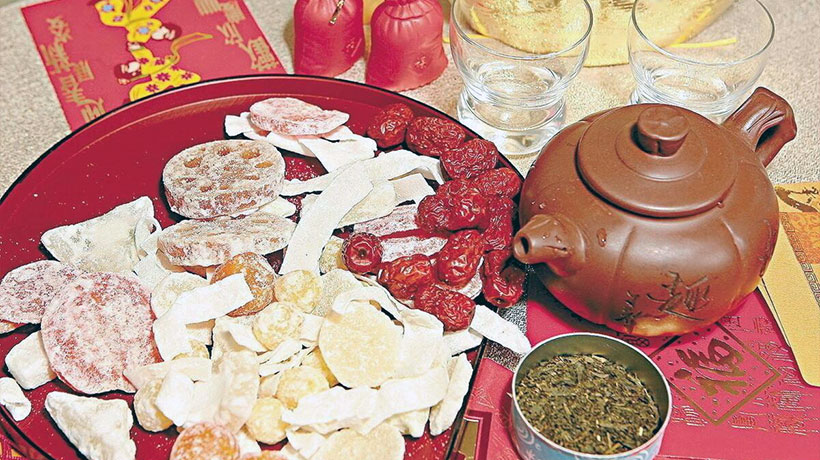
China's New Year custom culture has a long history, and various New Year customs have been derived from all over the country, which is very different from the north to the south, and each has its own characteristics. Although the customs vary from place to place, preparing New Year's goods and giving New Year's gifts are "must-haves" for New Year's Eve almost all over the country. Buying New Year’s goods, including food , clothing , wearing , using , sticking (New Year's red including couplets, blessings/"福" character, door gods, red envelopes, candles, firecrackers, fireworks, etc.), giving (New Year's greetings) gifts, candy , tea , meat , drinks , wine , etc., is collectively called "New Year's goods", and the process of purchasing New Year's goods is called "New Year's goods". Doing New Year's goods is an important activity for Chinese people to celebrate the Spring Festival.
No. 2: House Cleaning
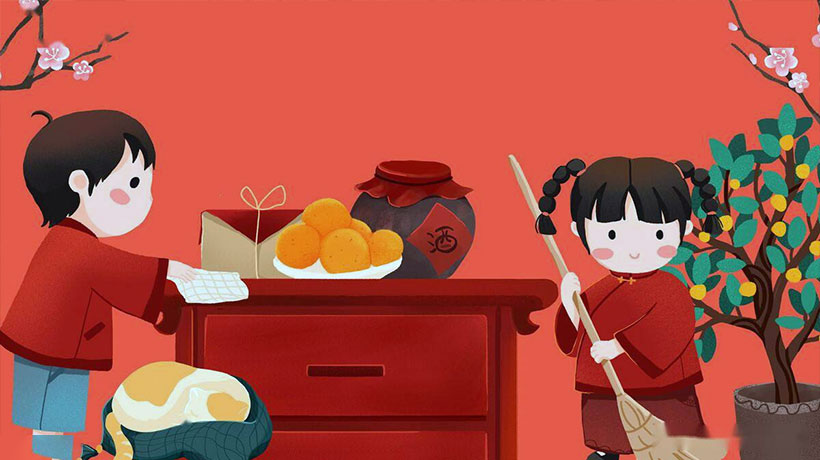
Among the folks, there is a custom of "sweeping the dust (also known as sweeping the house) on the twenty-fourth day of the twelfth lunar month. The folk proverb is called "twenty-four, sweeping the house / 腊月二十四 掸尘扫房子". The folks call it "sweeping the dust day". Clean the environment, wash all kinds of utensils, unpick and wash bedding and curtains, sweep the six-lumen courtyard, brush off the dirt and cobwebs, and dredge the open channels and underground ditches. There is a joyous atmosphere of rejoicing, cleaning, and welcoming the new year. According to folk sayings: Because of the homophony of "dust" and "Chen", sweeping dust before the year has the meaning of "removing old and bringing forth new". The purpose of sweeping dust is to sweep away all bad luck and bad luck, so as to pray for good luck in the coming year.
In the countryside, it is usually necessary to clean the inside and outside of the house, especially the cleaning of your brick and tile house is time-consuming and laborious. In addition, you have to clean the kitchen, pigsty and cattle pen separately. But now many rural families do not raise pigs and cattle, so there is no need for cleaning.
No. 3: New Year's Meat
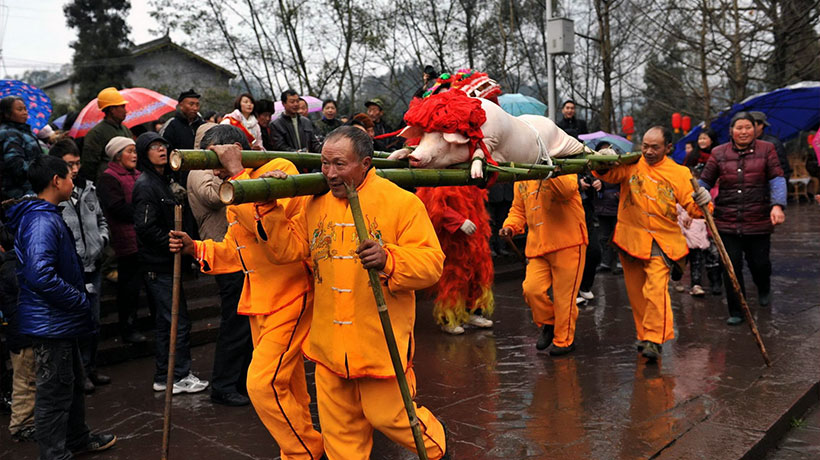
The folk proverb says "on the twenty-sixth day of the twelfth lunar month, kill the pig and cut the meat for the new year / 腊月二十六,杀猪割年肉 ", which means that the meat for the new year is mainly prepared on this day. The so-called slaughter of pigs is of course the killing of pigs raised by one's own family; the so-called cutting of meat refers to the poor people who do not raise pigs going to the market to buy meat for the New Year. The reason why "cutting the meat of the new year" was included in the New Year's Ballad is that the farming society and economy are underdeveloped, and people can only eat meat during the annual festival, so it is called "the meat of the new year".
Nowadays, many rural people don’t raise pigs anymore, and most of them go to the market to buy; some mountainous areas or ethnic minorities kill a pig during the Chinese New Year, some of them are used to give gifts to relatives, some are used to entertain relatives, and some are used to make bacon or sausage.
No. 4: Paste New Year Red
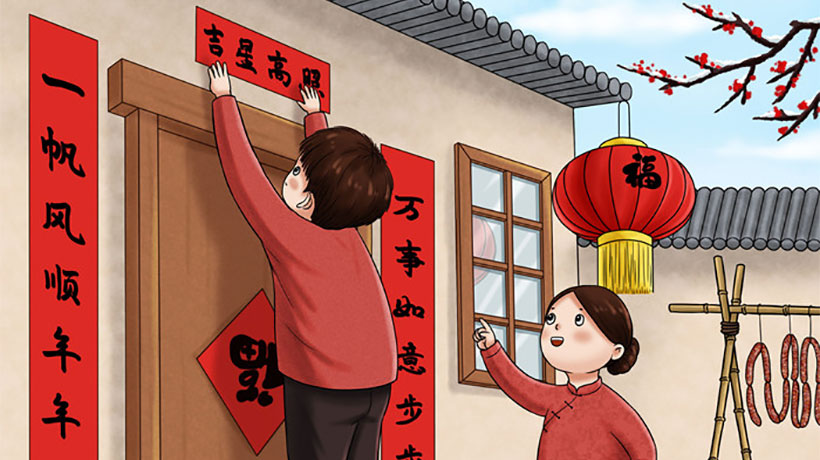
On the 28th, 29th or 30th day of the new year, every household "posts the New Year's Red" (the New Year's Red is the collective name for the red festive elements pasted during the New Year, such as Spring Festival couplets, door gods, horizontal batches, New Year pictures, and the word "Fu"). It is a traditional Chinese New Year custom to paste New Year's red, which adds to the festive atmosphere and places people's good expectations for the New Year and new life.
4.1: Spring Festival Couplets
- Chinese: 春联 / chūn lián
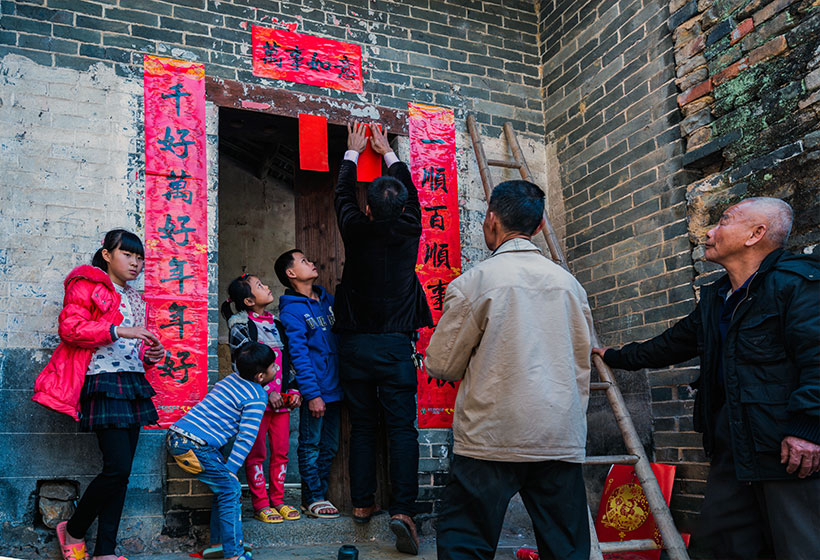
Pasting Spring Festival couplets is also called pasting couplets, etc. It depicts the background of the times and expresses good wishes with neat, dual, concise and delicate characters. It is a unique literary form in China. Every Spring Festival, no matter in the city or in the countryside, every household will choose a red Spring Festival couplet and paste it on the door to add a festive atmosphere to the festival.
4.2: New Year Pictures
- Chinese: 年画 / nián huà
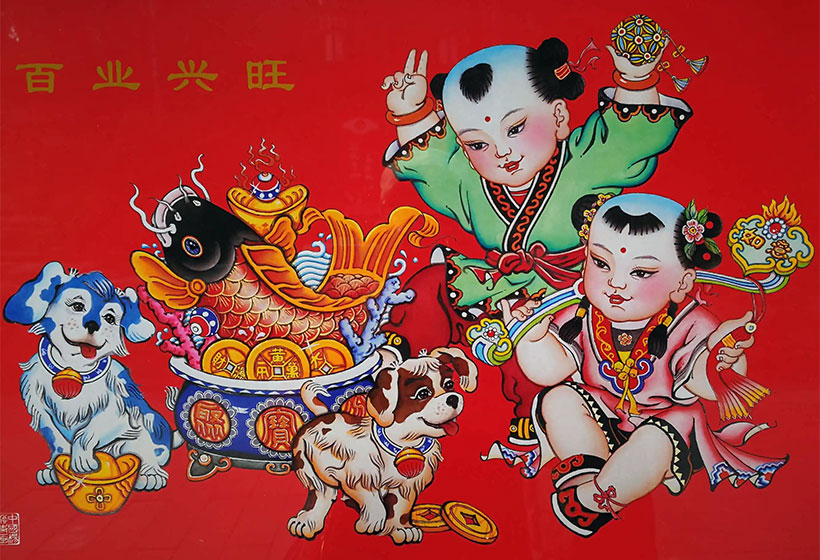
It is also common to hang and post New Year pictures during the Spring Festival in urban and rural areas. The thick and colorful New Year pictures add a lot of prosperity and joy to thousands of households. New Year pictures are ancient folk art in China, reflecting the people's simple customs and beliefs, and entrusting their hopes for the future. With the rise of woodblock printing, the content of New Year pictures is not limited to monotonous themes such as door gods but has become rich and colorful.
4.3: Paste Paper-cuts to Windows and the word "Fu"/福 (blessing)
- Chinese: 窗花 / chuāng huā 与“福”/ fú
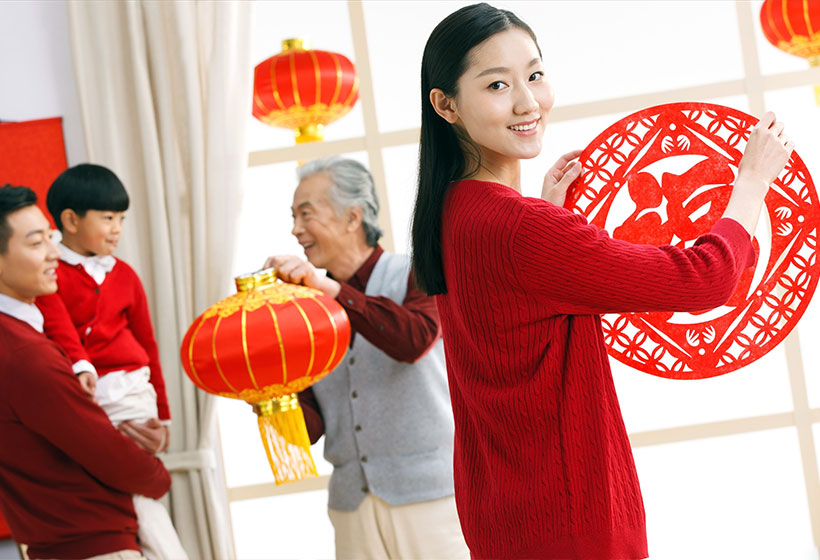
In the folk people also like to paste various paper-cuts on the windows - window grilles. Window grilles not only set off the festive atmosphere but also integrate decoration, appreciation, and practicality. At the same time, some families want to paste large and small "blessing" characters on the house door, walls, and lintels. There are also folks who make the word "Fu" into various patterns, such as longevity star, longevity peach, carp jumping over the dragon's gate, five grains and harvest, dragon and phoenix bringing prosperity, and so on.
No.5: New Year's Eve Dinner
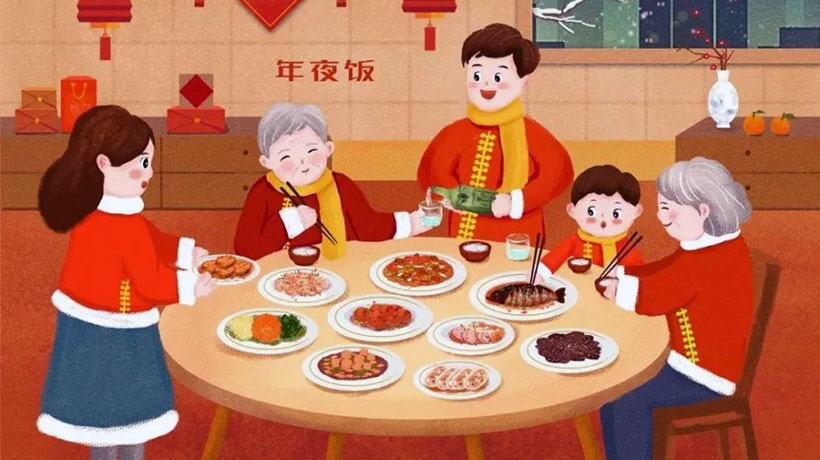
- Chinese : 年夜饭/ nián yè fàn
- When : some families have dinner at 2 or 3 pm, and some have dinner at about 6 pm
New Year's Eve dinner, also known as New Year's dinner, reunion dinner, etc., especially refers to the family dinner at the end of New Year's Eve. The New Year's Eve dinner originated from the ancient year-end sacrificial ceremony, where the family had a reunion dinner after worshiping the gods and ancestors. The New Year's Eve dinner is the highlight of the year, not only rich and colorful but also very meaningful. Before eating the reunion dinner, worship the gods and ancestors first, and the meal will not be served until the worship ceremony is over.
5.1: What do people often prepare for New Year's Eve Dinner?
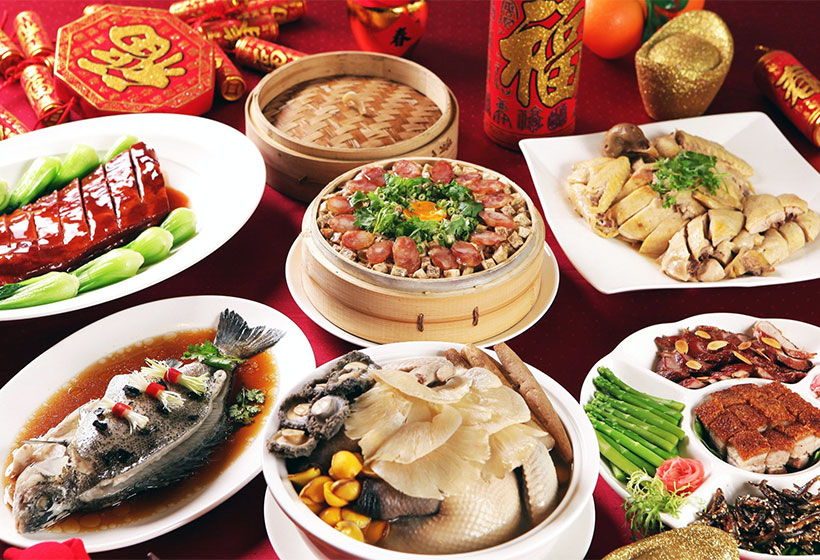
There are usually chickens (meaning planning), fish (meaning surplus every year), dried oysters (meaning good market), bean curd sticks (meaning abundance), lotus root (meaning smartness), lettuce (meaning making money), sausage (meaning long life) ) and so on for good luck. The Chinese New Year's Eve dinner is a reunion dinner for the family, and this is the richest and most important dinner at the end of the year.
5.2: Differences between North and South for New Year's Eve dinner
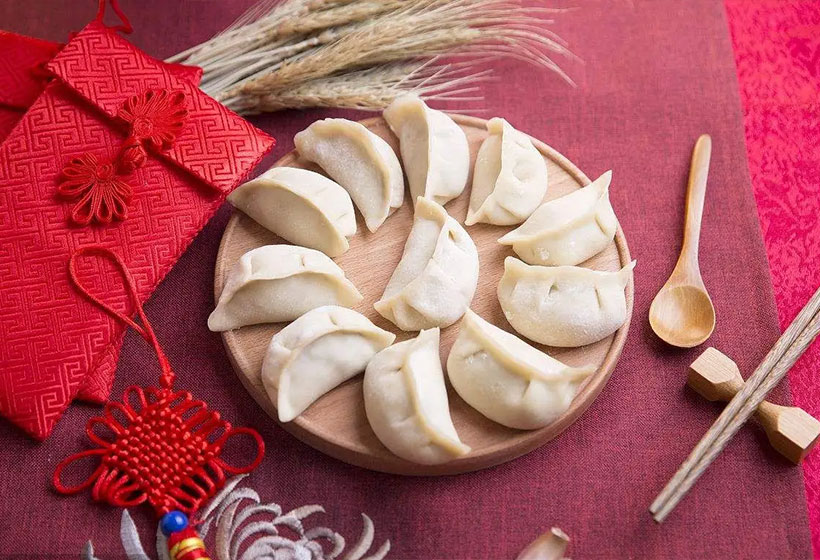
There are many famous places for New Year’s Eve dinners, which are different from the north and the south, and each has its own particularity. Northerners are used to eating dumplings during Chinese New Year, which is a habit handed down from ancient times. Due to geographical and climatic reasons, during the Spring Festival, the north is still in a cold winter, and it is basically impossible to grow crops, with scarce resources and few ingredients. The southern region, especially some coastal areas, is basically full of greenery all year round, and the southern region has a great advantage in vegetables and fruits in winter, so it has more choices in the choice of diet; in terms of geographical advantages, the southern water resources There are plenty of fish and various fish ingredients; so on some important festivals, the diet in the south is more abundant.
However, with the increasing number of large supermarkets and the convenience brought by online shopping and logistics, the difference in ingredients is getting smaller and smaller, and the current differences are only differences in eating habits.
No. 6: Staying Up(Shou Sui)
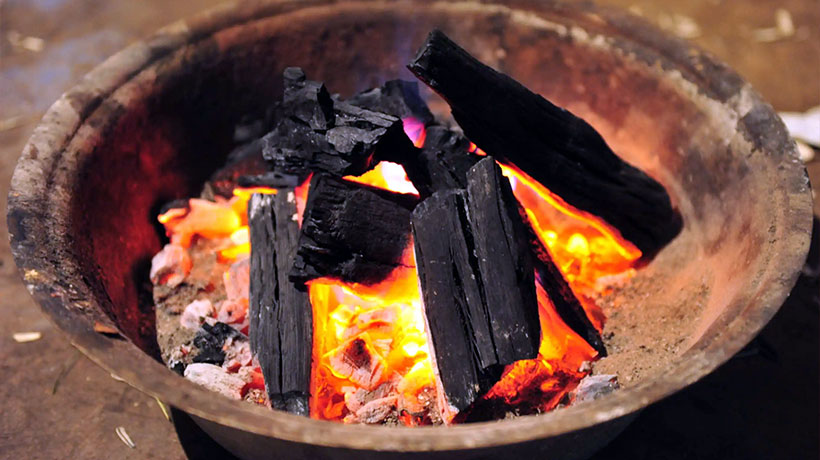
- Chinese : 守岁 / shǒu suì
- Meaning : Shou Sui is the custom of not sleeping on the last night of the old year and staying up late to welcome the arrival of the new year. In ancient times, Shou Sui had two meanings: elders' Shou Sui means "farewell to the old year", meaning to cherish the time; young Shou Sui means to prolong the life of their parents.
- What people do during Shou Sui : watch TV, play on the phone, play mahjong, play poker, set off fireworks or firecrackers, etc.
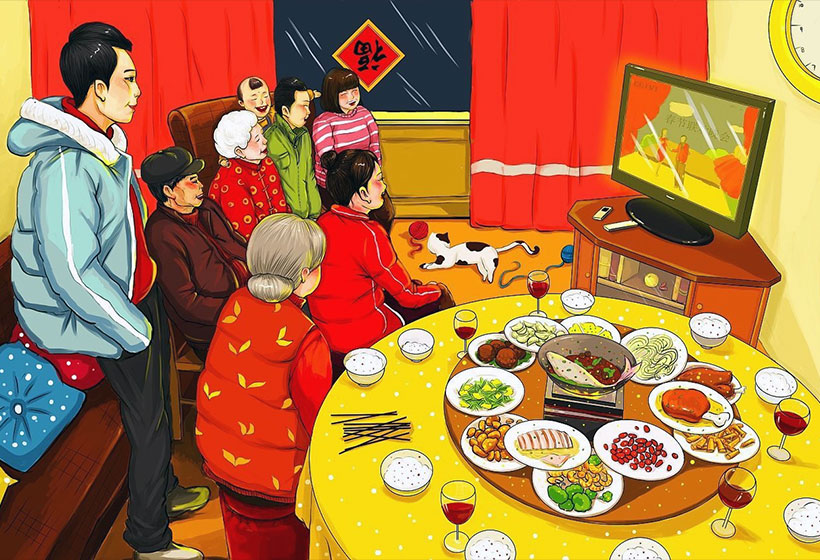
Shou Sui on New Year's Eve is one of the annual activities, and the custom of Shou Sui has been around for a long time. The folk custom of Shou Sui is mainly manifested in that all the houses are lit with new year fires, the family gathers together , and keep the " Shou Sui Fire " from extinguishing, waiting for the moment of saying goodbye to the old and welcoming the new year.
On New Year's Eve, the whole family gathers together, has a New Year’s Eve dinner, lights candles or oil lamps, sits around the fire and chats , and stays up all night to watch, which symbolizes driving away all evil plagues and diseases, and looks forward to good luck in the new year.
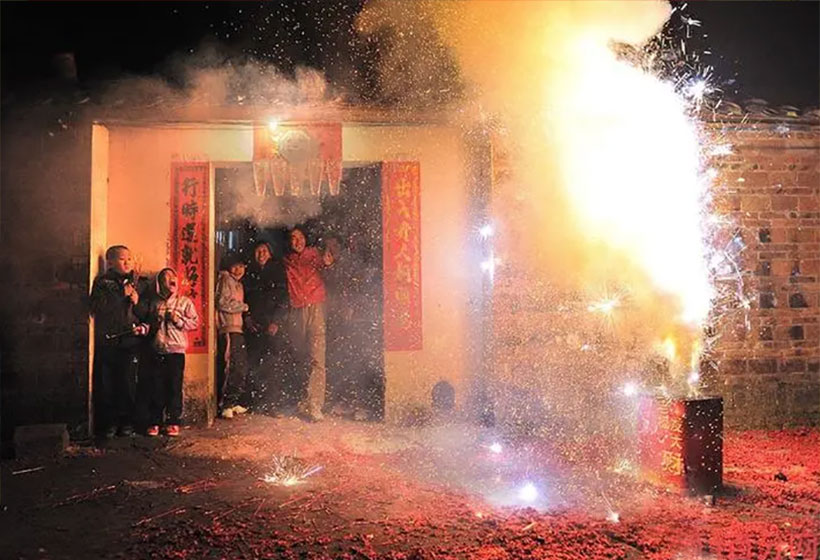
In the south, usually at 12 o'clock on New Year's Eve, every household in rural areas will set off firecrackers and fireworks on time to welcome the arrival of the New Year. Some families start giving red envelopes(lucky money) to their children after 12 o'clock, hoping that the children will grow up healthily and everything goes well in the New Year!
NO.7: Lucky Money / New Year's Money / Red Envelope
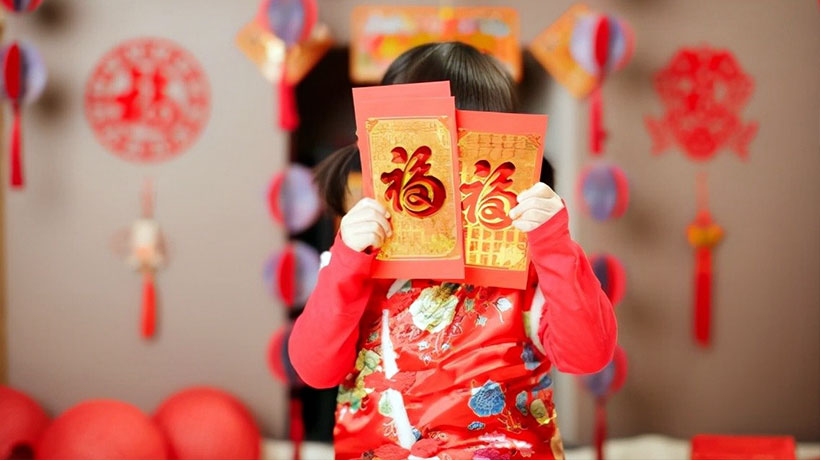
- Chinese : 压岁钱/红包, yā suì qián / hóng bāo
- How much : from RMB10-800 or more
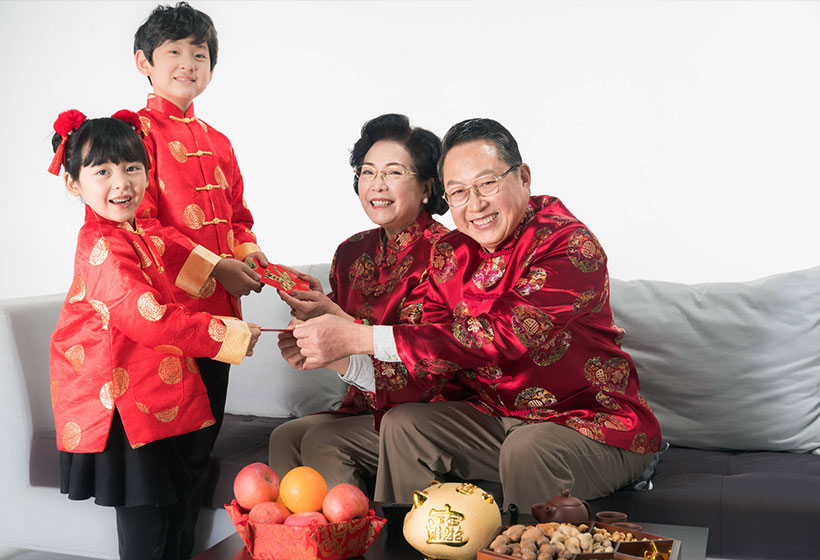
It is said that "lucky money" can suppress evil spirits, and the younger generation can spend the first year safely with the lucky money. In folk culture, lucky money means to ward off evil spirits and drive away ghosts and bless peace. The original purpose of lucky money was to suppress evil and exorcise evil spirits. Because people think that children are vulnerable to ghosts and ghosts, they use lucky money to drive away ghosts and ghosts.
Generally, during the countdown to the new year, the elders distribute "lucky money" to the younger generations, expressing pressure and embodying the elders' concern and sincere blessings for the younger generation. Another kind of "New Year's money" is given to the elderly by the younger generation in the hope of longevity for the elderly.
No.8: Temple Fair
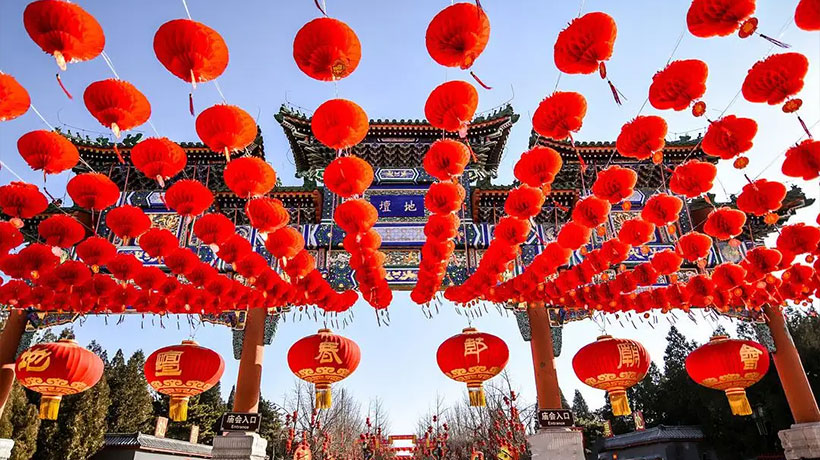
- Chinese : 庙会 / miào huì
- When : from the first day of the New Year to the end of the Lantern Festival, the period varies in different cities.
- Activities : traditional opera, puppet show, comic dialogue, sketch, double reed, magic, Yangko dance, walk on stilts, Diabolo, revolving lantern, rattle, etc.
- Food : Sugar-coated haws, sugar painting, sugar-figure blowing, marshmallow, steamed rice cake, Chinese hamburger(Roujiamo), coold noodles, barbecue skewers, etc.
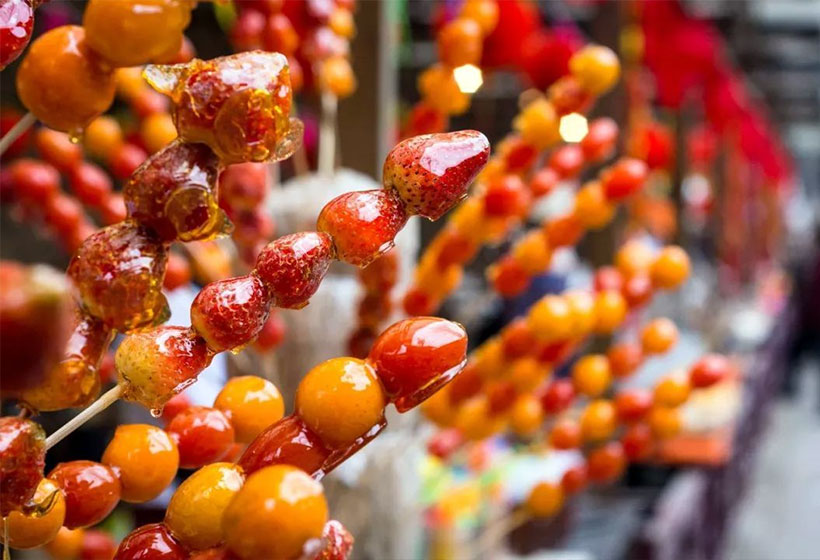
Visiting temple fairs is one of the most lively folk activities during the Spring Festival. Guangfu Temple Fair and Beijing Ditan Temple Fair are also known as the two major temple fairs in China. The content of the temple fair covers puppet collection, Chinese unique skills, martial arts conference, Lantern Festival and other themed activities, and includes rich content such as blessing culture, folk culture, food culture, business and leisure culture.
Visiting temple fairs during the Spring Festival is the most important way to experience Chinese traditional culture.
No. 9: Pay a New Year call
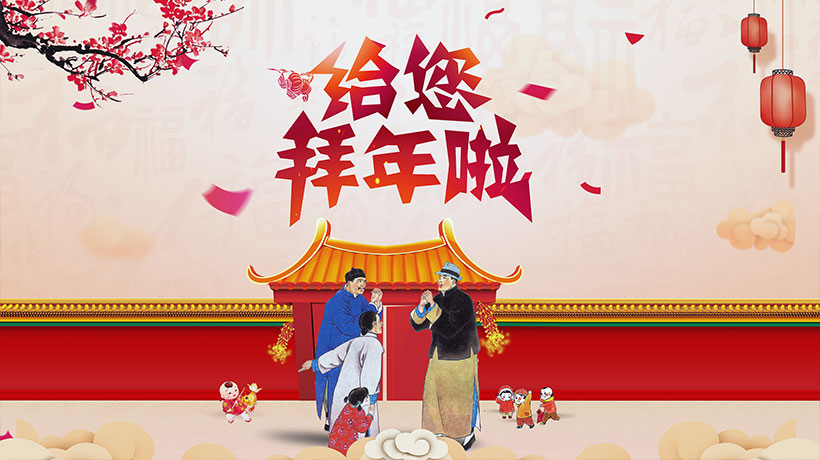
- Chinese: 拜年 / bài nián
Visiting during the Spring Festival is one of the traditional customs of the New Year, and it is a way for people to bid farewell to the old year, welcome the new year and express good wishes to each other. On the second and third days of junior high school, I started to visit relatives and friends, visit each other, congratulate each other, and say congratulations on Xinxi, Gong Xi Fa Cai , Congratulations , and Happy New Year . The meaning of New Year's greetings is to visit relatives and friends to connect with each other, congratulate each other on the New Year, express feelings for relatives and friends and best wishes for life in the new year. With the development of the times, the custom of paying New Year's greetings is constantly adding new content and forms.
There are two types of New Year greetings
1 . New Year greetings to brothers, uncles, grandparents and grandma who live in the same place. This kind of New Year greetings do not need to bring gifts, just prepare red envelopes;
2 . New Year greetings to uncles, aunts and sisters who are not in the same village. , You need to bring gifts such as milk, wine, chickens and other gifts to celebrate the New Year.
Seasonal food
The Spring Festival is the traditional festival that Chinese people pay the most attention to. On the eve of the Spring Festival, every family will spend a long time preparing for the Spring Festival. So what are the must-eat foods for Spring Festival? Let's take a look below.
Main Dishes
- Chinese: 饺子 / jiǎo zi
Dumplings are an indispensable food for the New Year’s Eve dinner table in the north. Dumplings are shaped like ingots. Eating dumplings during the Spring Festival means “to attract wealth and treasure”. People will also wrap coins in the dumplings. There will be good fortune.
Deserts and Snacks
Desserts and snacks are indispensable in Chinese New Year’s delicacies, such as rice cakes, glutinous rice balls, Steamed sponge cake, Chinese rice pudding, Fried dough twist, Fried flour-coated peanuts, etc., which are loved by children and the elderly.
No. 1: Nian Gao (Rice Cake)
- Chinese: 年糕 / nián gāo
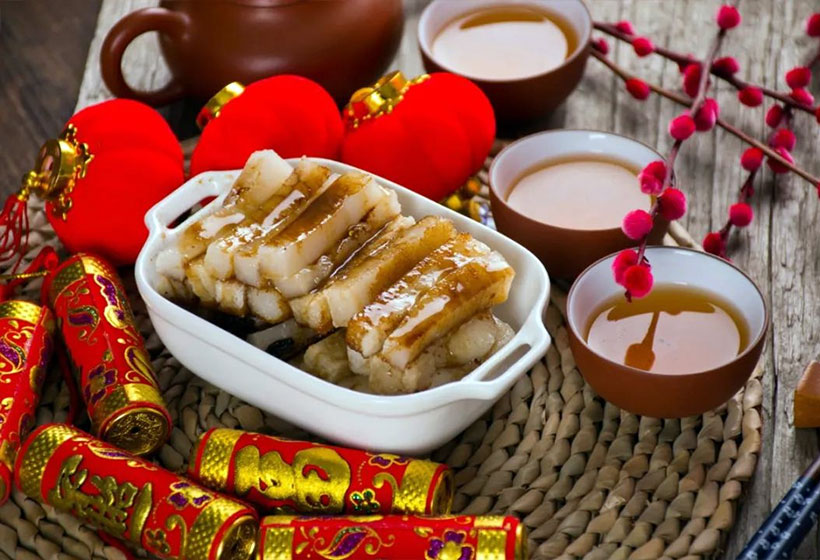
In the early Suzhou people, to commemorate Wu Zixu(famous military strategist, 559 BC - 484 BC.), they made new year cakes during the Chinese New Year. Later, they gradually became popular all over the country, such as red date rice cakes in Shandong, minced fruit rice cakes in Beijing, taro rice cakes and brown sugar or white sugar rice cakes in Fujian, water-milled rice cakes in Ningbo, and rice cakes in Suzhou. Osmanthus sugar rice cake and so on. Nian Gao, a homonym for "nian gao", is a must-have food for the Spring Festival, and it entrusts people's expectation that everything will develop for the better.
No. 2: Glutinous Rice Ball
- Chinese: 汤圆 / tāng yuán
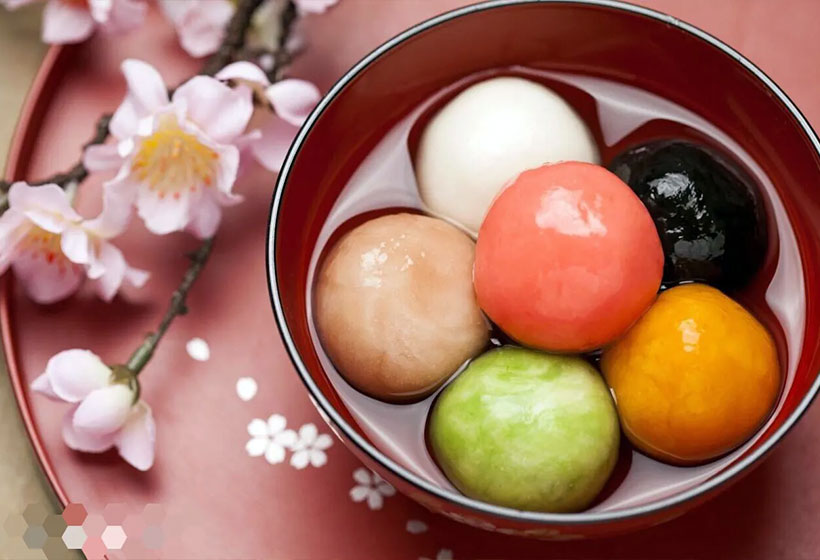
The Lantern Festival food in the south is called "Tangyuan", also known as "Yuanxiao", "Tangyuan" and "Floating Yuanzi". It is one of the representatives of traditional Chinese snacks and is a spherical food made of glutinous rice flour. Generally, there are fillings, boiled and eaten with soup. It is also the most distinctive food of the Lantern Festival. Use black sesame seeds and lard as filling, add a little white sugar, and roll the outside into a round shape with glutinous rice flour. Because this kind of glutinous rice dumpling floats and sinks when boiled in a pot, it was first called "Fuyuanzi", and later in some areas, "Fuyuanzi" was renamed Tangtuan. In Jiangsu, Shanghai and other places, there is a custom of eating glutinous rice balls on the morning of the first day of the Lunar New Year.
Red envelopes ("hongbao" in Chinese pinyin) are sold all around the markets and streets. They are used to put money in a red envelope and the money is called "ya sui qian", symbolizing the warding off, or suppression of evil. Usually, adults or older people give red envelopes with any amount of money (it can be 5 yuan or 100 yuan or more) to the juniors. On the cover of the red envelopes, there are usually icons of what the year belongs to or some common greetings like "Xin Nian Kuai Le" (Happy New Year) and "Ji Xiang Ru Yi" (wish everything goes well for you). Some people don't use any red envelopes, instead, they give money to the younger directly.
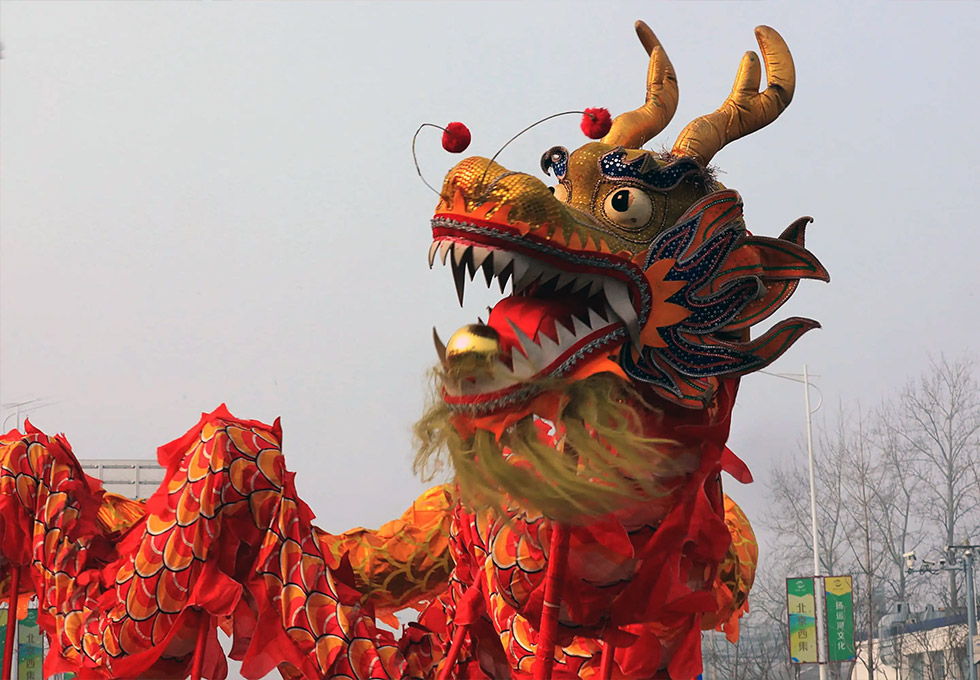
Dragon dances and lion dances are very popular and common during the Chinese New Year. From the 1st day of New Year to the 15th day, streets and homes are filled with dragon and lion dances. They are formed by a group of people, some of whom manage the "dragon" and the "lion", while some beat the drums. It is believed that the loud noise created by the drums, along with the faces of the dragon and lion scare away evil spirits.
When the New Year celebration ends on the 15th day of the New Year, there comes the Lantern Festival. On the evening of that day, in some places, people make lanterns and put them into a main river and just let them flow with the currents. In other places, there are lantern parades. People bring lanterns with them and walk on the streets. Young men may highlight the parade with a dragon dance.
Do you know these New Year phrases?
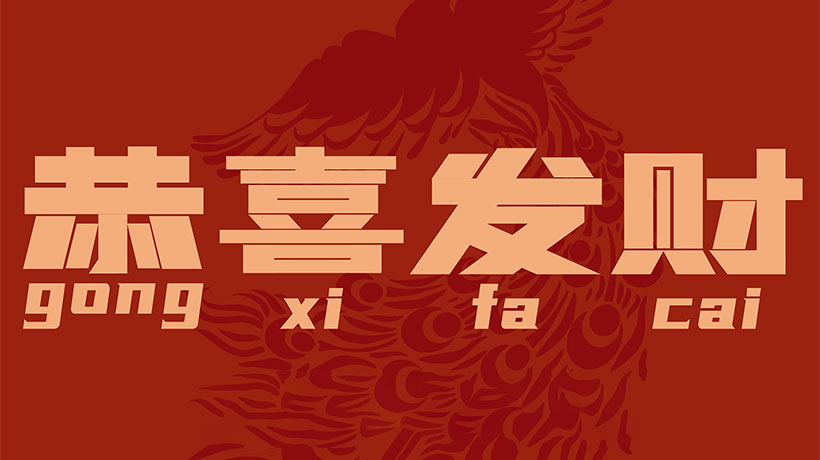
- For everyone you meet: Happy new year! - 新年快乐 /xīn nián kuài lè
- For seniors: Everything goes well and perfect health - 万事如意, 身体健康/ wàn shì rú yì, shēn tǐ jiàn kāng
- For students and young people: May all your wishes come true - 心想事成 / xīn xiǎng shì chéng
- For business people: Wish youa great fortune! - 恭喜发财 / gōng xǐ fā cái
- For business people: Wish your business success - 生意兴隆 / hēng yì xìng lóng
- For those who work: Promoting to a higher position - 步步高升 / bù bù gāo shēng
- Pun: I hope you make a killing and give me a red envelope(New Year's Money)! - 恭喜发财,红包拿来!
Where can I experience the nyear'sear atmosphere and activities?
New year travel itineraries.
- Make bamboo lion head in your Guilin trip >>

Hi, I’m Nora Zheng, if you like my article, please share it with your friends. Any sugguestions on this article, please contact me . Thanks!
Want to plan a private China tour? CREATE NOW
CONTENT DIRECTORY
CREATE MY TRIP
FABULOUS TOUR COMPANY
CHINA OCTOBER - NOVEMBER 2019 We researched several companies and studied reviews on Trip Adviser before contacting who did a very China Culture Tour with an initial query. Right from the outset Grace who owns the company was excellent. She emailed detailed with pictures information and a suggested… read more details
Karen from US
Ready to Create a Unique Dream Travel?
Create My Vacation
- CHINA CULTURE TOUR: OUR CULTURE, YOUR TOUR!
- Best Tailor-made Classic China Tours
- Cultural Experiences for a China Tour
- WOW Seasonal China Tours
- Our Best Tour Ideas for You
Essay: This Chinese New Year, Make Noise, Be Brave, Create Your Own Luck
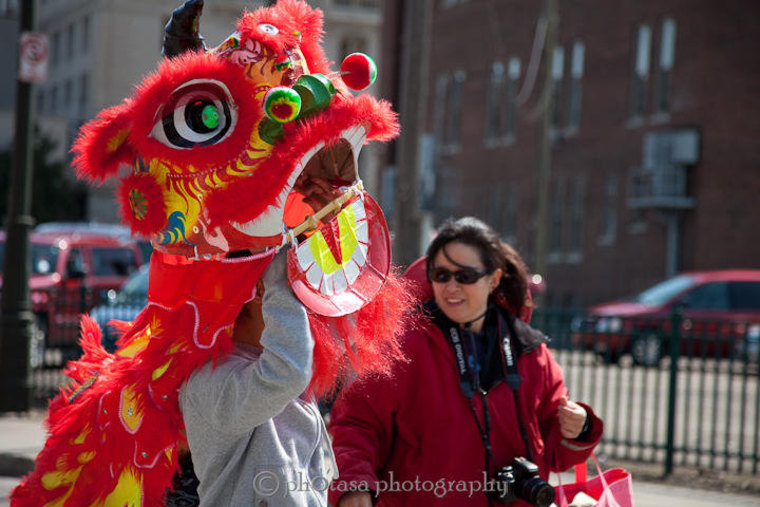
Chinese New Year celebrations are all about new beginnings and fresh starts. The new year is a time of hope and good luck.
How one spends the first day of the new year is supposed to foretell how the rest of the year will go. On Lunar New Year’s Day — this past Saturday — parents are not supposed to scold their children, brothers and sisters are not supposed to argue, and (pro tip) no one is supposed to cook or you will end up scolding, arguing, or cooking all year.
Some say that the first person to come visit your house on Lunar New Year’s Day will foretell what the new year will bring. Instead of leaving it up to chance, some people actually arrange for a rich person to come to their door first thing to ensure that their new year will be full of riches.
I am not really that superstitious, so, although I teach my children these old Chinese traditions , I am OK with occasionally nodding toward the spirit of the idea even if we do not get the letter of it exactly right.
RELATED: 10 Lunar New Year Facts to Help Answer Your Pressing Questions
Celebrated jazz pianist and composer Jon Jang is coming to town for a big concert next week. I plot — if the university has not already made plans for him — that maybe I can invite him to our house for dinner, ensuring that our new year will be filled with music, arts, and activism. Maybe I am superstitious enough to believe that this will be one small act of supernatural resistance against reportedly proposed funding cuts to the National Endowment for the Arts and the National Endowment for the Humanities .
"All I want is quiet. But if the news of the past week is any indication, this is not going to be a quiet year."
But our weekend is full of soccer, academic games, Chinese school, and Chinese traditional orchestra rehearsal. Scheduling is going to be tricky. I am invited to a professor’s Lunar New Year party at which Jang will be a guest. Close enough!
Music, arts, and activism may not come to our house directly, but we will be spending the year with them.
Before Lunar New Year’s Day arrives, one is supposed to settle all debts, resolve all fights, clean the house top to bottom, and wrap up the old year so that the new year can begin fresh.
Instead, I usually end up treating the Lunar New Year as an extension, an extra month or two to finish up the old calendar year before I have to start thinking about the new.
On Jan. 1 when people ask, “What are your New Year’s resolutions?” I answer, “Oh, I’m Chinese American, I still have another month.”
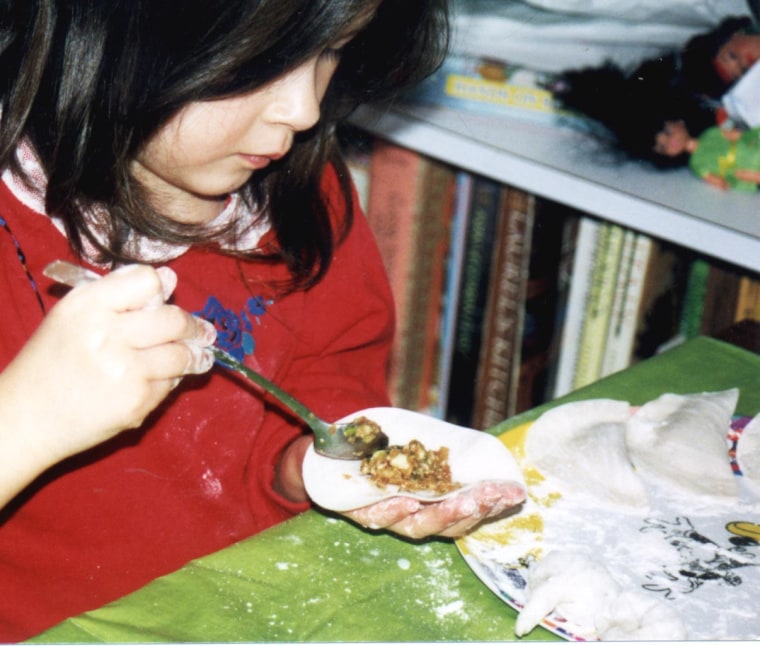
However, this past year, I have been feeling so overextended that I have been actively trying to pare down my commitments so that I am not obligated to too many others. During the two weeks of winter break that my children were out of school, I did not leave the house. I just sat in my kitchen, and I worked. Somehow, miraculously, I finished all of my 2016 commitments by Jan. 7, 2017, a first ever for me. I remember spending all of Jan. 8 in a daze. I had new stuff I could do, but there were no emergencies, no fires to put out. Then school started again on Jan. 9 and we were back to frantic freneticism.
RELATED: New Book on Civil Rights Icon Fred Korematsu Challenges Youth to Speak Up for Justice
All I want is quiet.
But if the news of the past week is any indication, this is not going to be a quiet year.
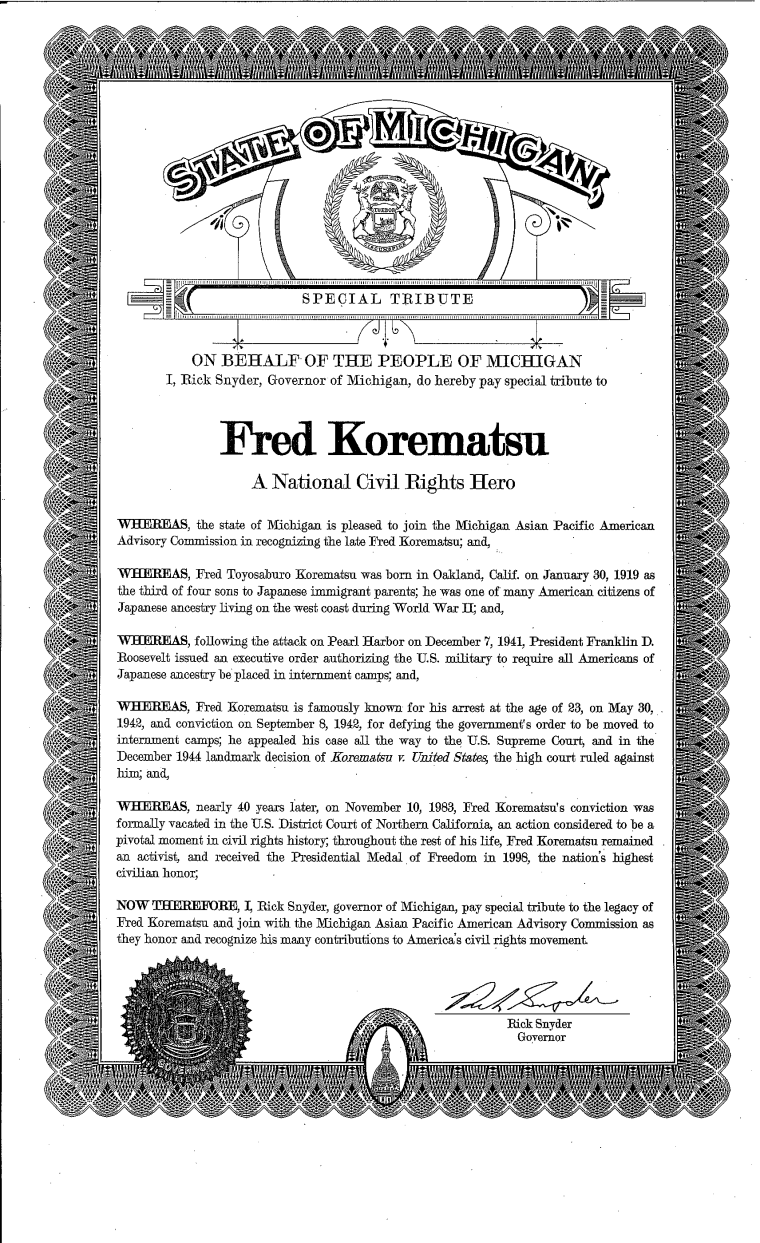
Monday, Jan. 30, is recognized by several states as the Fred Korematsu Day of Civil Liberties and the Constitution . Korematsu challenged the constitutionality of the incarceration of Japanese Americans during World War II, which helped pave the way for redress and reparations for the Japanese-American community in the 1980s.
Although Korematsu received the Presidential Medal of Freedom, he was also a somewhat reluctant activist. He was only 23 years old at the time and just wanted to hang out with his European-American girlfriend. Yet, once he started fighting, he wanted to make sure that the same thing could never happen to anyone again. He spent the last years of his life standing up for the Muslim-American community after the events of Sept. 11, 2001.
This year will be the 135th anniversary of the Chinese Exclusion Act , which banned Chinese from entering America from 1882 to 1943. It is also the 75th anniversary of Executive Order 9066 , which incarcerated about 120,000 Japanese Americans, two-thirds of whom were American citizens, in incarceration camps during World War II. It is also the 35th anniversary of the baseball bat beating death of Chinese American Vincent Chin by auto workers who blamed the Japanese for the troubles of the automotive industry. These events are all connected.

On Holocaust Remembrance Day, President Trump signed an executive order to ban people from several Muslim-majority countries and to halt the entry of refugees . Refugees, international students, and U.S. permanent residents — who had visas and were already in the air when the order was signed — were not allowed entry upon arrival at the airport, followed by a weekend of mass protests at airports around the country and an emergency stay of the order.
“Don’t be afraid to speak up,” Korematsu had said. “One person can make a difference, even if it takes 40 years.”
So on Monday, I will be at the law school’s Korematsu Day program — with members of the Japanese American Citizens League, American Citizens for Justice, and the Arab Community Center for Economic and Social Services (ACCESS) — speaking up about this history and the importance of standing up for others, especially today.
I will be thinking about all the ways that I am privileged to speak, and I will be carrying with me the thousands of people who have been standing up, marching, and protesting for others; the dark humor and new-found resistance of historians, scientists, and park rangers; the courage of Native Americans and veterans protecting the environment at Standing Rock; the image of volunteer attorneys sitting and working on the floors of airports; and the conviction of the New York Taxi Workers Alliance who went on strike at JFK Airport Saturday in protest of the executive order.

Chinese New Year is a boisterous, magical time, with firecrackers and lion dances to scare away bad luck and evil spirits and to set the tone for the new year. Chinese New Year traditions are not about waiting and hoping for good luck to arrive, but about taking steps to make sure that it happens.
So make noise. Be brave. Create your own luck to shape this new year.
Follow NBC Asian America on Facebook , Twitter , Instagram and Tumblr .
- Essay: Looking to Martin Luther King Jr. Day to Light the Way Forward
- Essay: Celebrating Chinese New Year Far From Home and Family
- Essay: In the 'Las Vegas of Asia,' Lessons in How Multiculturalism Makes Community
- Essay: The Day after Election Day, What Do I Tell My Son?
Frances Kai-Hwa Wang is a freelance writer and speaker based in Michigan and Hawaii. She has been a contributor for AAPIVoices.com, NewAmericaMedia.org, ChicagoIsTheWorld.org, PacificCitizen.org and InCultureParent.com. She teaches Asian Pacific American Studies and writing and she speaks nationally on Asian Pacific American issues.
Home / Essay Samples / Culture / Holidays / Chinese New Year
Chinese New Year Essay Examples
Chinese reunion dinner: celebrating family and tradition.
Chinese New Year is known to be full of peace and a cheerful holiday that is normally celebrated for the first fifteen days of the year. It is also known to be days of family reunion when all family members would finally come back home...
Barongsai: Chinese New Year Celebration in Indonesia
Maybe you often hear about Chinese New Year or Tahun baru imlek, the Chinese community in Indonesia always celebrate Imlek every year. By the way, do you know that there is one show which is always enlivening the Chinese New Year in Indonesia? Yup! The...
Analysis of the Behavior and Rituals of My Family for the Chinese New Year
In this essay, I will be using Geertz’s interpretive methodology to analyse the behaviour and rituals practiced by my family during reunion dinners at Chinese New Year. Having been involved in this social gathering since young, I can draw many observations and conclusions about the...
The Positive and Negative Effects of the Chinese New Year
The first high-quality of Chinese new for social and lifestyle is to let people comprehend greater about the New Year’s regular culture, have a deeper grasp of the New Year’s traditions and culture, and hold the normal culture of the New Year, and via the...
Trying to find an excellent essay sample but no results?
Don’t waste your time and get a professional writer to help!
You may also like
- Indian Culture
- American Culture
- Spring Break
- Multiculturalism
- Japanese Culture
- Valentines Day
- Western Civilization
- Halloween Essays
- Thanksgiving Essays
- Diwali Essays
- Christmas Essays
- Holi Festival Essays
- New Year Essays
- Winter Break Essays
- Day of The Dead Essays
- Mothers Day Essays
- 4Th of July Essays
samplius.com uses cookies to offer you the best service possible.By continuing we’ll assume you board with our cookie policy .--> -->